
We have received your request correctly.
You will receive an email with a summary of your bookings.
Can't find it? Leave us your email and we'll send you a summary of your bookings.
Share it straight to social media with your campaign ID and name

Reina Sofía Museum Guided Tour
- 7.30 / 10 500 reviews | 4,013 travellers Entertaining and educational activity 8 Jose
- Free cancellation up to 24 hours before the service starts
With one of the best Spanish contemporary art collections in the world, the Reina Sofía art gallery is the second-most visited museum in Madrid , after the Prado Museum . Visit this iconic landmark with an expert guide and learn about the gallery’s masterpieces.
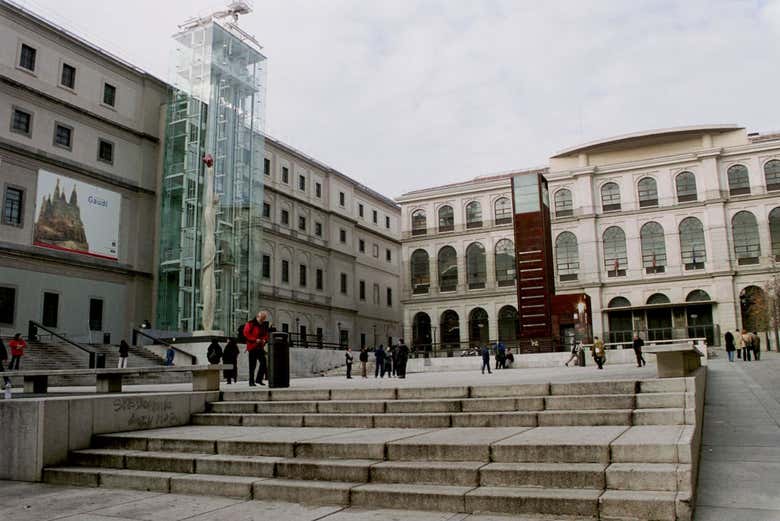
Walk into the former hospital building which houses the Reina Sofía led by your guide and marvel at world-renowned 20th-century artists’ work such as Juan Gris, Joan Mir ó, Salvador Dal í and Pablo Picasso .
Learn about Spanish culture and history wandering through the various rooms and the several art movements like modernism, cubism and surrealism . Admire one of the world’s most forceful and striking anti-war paintings, Picasso ’s “Guernica ” .
Why reserve a guided tour?
As well as being inexpensive, this guided tour is the best way to explore the Reina Sofía’s masterpieces in just 2 hours .
Up until the 23rd of March 2024 (included), the tour will carried out in a bilingual form, through the medium of Spanish and English .
From the 24th of March 2024 (included), the tour will be carried out solely in English (monolingual)
Visita privada
Existe la posibilidad de hacer el tour de forma privada por 135€ (precio por grupo de hasta 25 personas sin incluir entradas).
More Information
1 hour 30 minutes.
The activity takes place with a guide that speaks in English.
Entrance to Reina Sofía Museum
Expert English–speaking art history guide
When to book?
You can book up to the start time, as long as there are places remaining. Book now to guarantee your spot.
Type of voucher
Electronic. Show the voucher on your phone.
Accessibility
Physical : Wheelchair accessible. This must be indicated in the reservation. Accessible toilets. Free wheelchair loan service available. Show more
Visual : Has measures for visual accessibility. Provides signage for wayfinding and orientation. Information in accessible formats. Audible security and alarm system.
Auditory : Has measures for hearing accessibility. Staff with knowledge of sign language. Offers technological adaptations for the deaf. Security system and visual alarm.
Intellectual : Has measures for cognitive accessibility. Information in easy-to-read format. Signage with easily recognisable pictograms. Security system and visual and audible alarm.
Sustainability
All services published on Civitatis are carried out in accordance with our Sustainability Code .
Our providers commit to:
- Provide a safe and satisfying experience.
- Reduce, reuse, recycle.
- Incorporate eco-conscious technologies.
- Uphold fair employment standards.
- Foster the growth of local communities.
- Preserve the integrity of local culture.
- Safeguard both cultural and environmental heritage.
- Ensure ethical treatment of animals.
- Operate with honesty and transparency.
- Encourage sustainable behaviors among customers and staff.
This particular activity contributes as follows:
- Printed material is avoided.
- No single-use plastics are used.
- The activity helps the dissemination of local cultural heritage.
- No printing of documentation required.
- Promotes local employment.
- Has a gender equality policy.
Amigo Tours España Show more
Corporate name: Amigo Tours New York LLC
Not permitted.
Frequently asked questions
Q - Why do this activity with Civitatis?
A - At Civitatis we guarantee the best quality and prices, click here if you want to know how we select our activities.
Q - How to book?
A - To reserve the activity, choose the date and complete the form on this page. You will receive your confirmation immediately.
Q - Is a minimum number of participants required?
A - This activity requires a minimum of 2 participants. Should this number not be reached, we'll get in touch with you to offer alternatives.
If you have any other questions please contact us.
Free cancellation
Meeting point.
In front of the Reina Sofía Museum's main entrance, in Calle de Santa Isabel
You may also be interested in
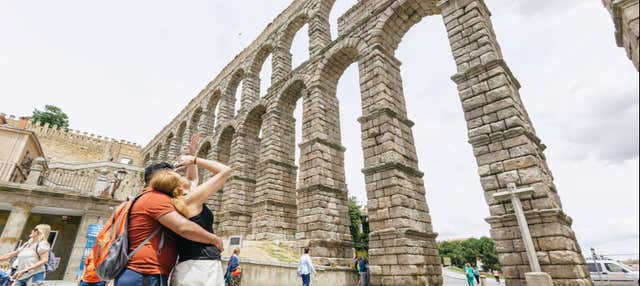
Toledo and Segovia Tour
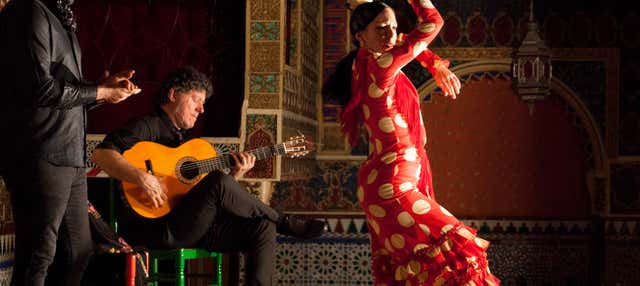
Torre Bermejas Flamenco: The Best Flamenco Show & Dinner in Madrid
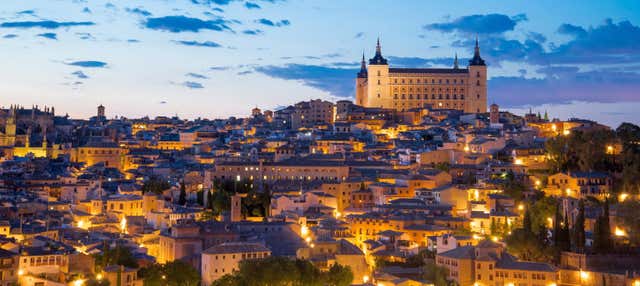
Complete Toledo Day Trip
Login to add activities to your favorites and access them from any device
This site is reCAPTCHA protected and Google's privacy policy and terms of service apply.
Log in to rate the opinions of other travelers
Guided Tours
Service temporarily unavailable.
- Top Destinations
- Mexico City, Mexico
- Tokyo, Japan
- Paris, France
- Rome, Italy
- London, United Kingdom
- All Destinations
- Upcoming Experiences
- Walking Tours
- Small-Group Tours
- Tours for Kids
- Museum Tours
- Food, Wine and Market Tours
- Newly Added Tours
- Audio Guides
- Pre-Trip Lectures
- Admin Dashboard
- My Favorites
- Cookies Preferences
- Client Orders
- Monthly Commissions
- My Advisor Profile
- Advisor Toolkit
- Guide Dashboard
Credit Balance
Transactions are based on current exchange rates and performed in USD. There maybe slight variations in the price estimates.
Reina Sofia Museum Tour: A Guided Crash Course with Skip-the-Line Tickets

- Explores highlights of the museum including Picasso's masterpiece, Guernica
- Led by a local art historian
Private Reina Sofia Museum Tour
Guernica in context, reina sofia museum with an expert, faq about the reina sofia museum private tour.

Reviews can only be left by Context customers after they have completed a tour. For more information about our reviews, please see our FAQ .
You May Also Like

Prado Museum Tour: A Guided Crash Course with Skip-the-Line Tickets
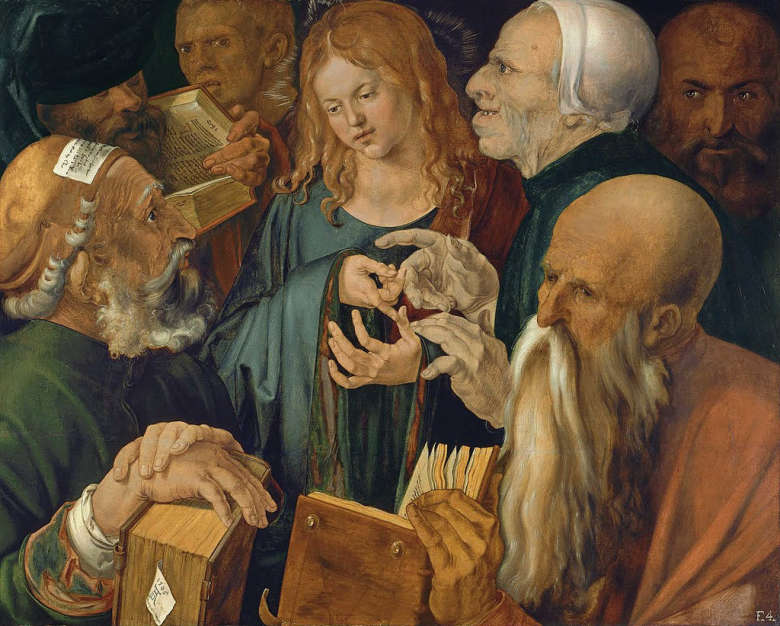
Thyssen Bornemisza Museum Tour: A Guided Crash Course with Skip-the-Line Tickets
Book a tour.
- Our Experts
- Working with Context
- View All Cities
- Sustainable Tourism
- Refer a Friend for $50
- Travel Updates
- Advisor Login
- Expert Portal
Subscribe to our Newsletter
- Privacy Statement & Security
- Cancellation Policy
- Top 10 Things to Do
- Top 10 Places to See
- Top 10 Best Cities to Visit
- Top 10 Best Holiday Resorts
- Top 10 Best Museums
- Top 10 Historical Sites
- Top 10 Best Theme Parks
- Top 10 Best Water Parks
- Top 10 Best Beaches
- Top 10 Best Festivals
- San Sebastian
- Santiago de Compostela
- Benidorm, Costa Blanca
- Magaluf, Majorca
- Benalmadena, Costa del Sol
- Playa d’en Bossa, Ibiza
- Sant Antonio, Ibiza
- Alcudia, Majorca
- Es Pujols, Formentera
- Torremolinos, Costa del Sol
- Playa del Ingles, Gran Canaria
- Corralejo, Fuerteventura
- Puerto del Carmen, Lanzarote
- Gran Canaria
- Fuerteventura
- Costa Blanca
- Costa Brava
- Costa del Sol
- Costa Dorada

Reina Sofia Museum in Madrid: What to See + Tickets + Tips
The Reina Sofia Museum is one of the most important museums in Spain, known for its impressive collection of contemporary art. It is one of the world’s foremost contemporary art museums. It houses a stunning collection of works by famous artists such as Pablo Picasso, Salvador Dali, Joan Miro, and many others. With a collection of over 20,000 works, it is a must-visit destination for art lovers, as well as one of the top 10 places to visit and see in Madrid . In this guide, we’ll take a look at what to expect from your visit to the Reina Sofia Museum and what to see, visiting tips, tickets and guided tours while you’re there.
Table of Contents
Top Facts about Reina Sofia Museum
- The museum is named after Queen Sofia of Spain and was officially inaugurated in 1992, coinciding with the Universal Exposition held in Seville.
- The museum is home to a vast collection of contemporary art, with works from famous artists such as Pablo Picasso, Salvador Dalí, Joan Miró, and many others.
- The most famous piece in the collection is undoubtedly Picasso’s “Guernica,” which is on permanent display in the museum.
- The museum’s collection is primarily focused on Spanish art from the 20th century to the present day, but also includes works from other parts of the world.
- The museum’s building was originally a hospital, constructed in the 18th century, which was later converted into a museum.
Quick History of Reina Sofia Museum
The Reina Sofia Museum was initially founded in the late 1980s to house contemporary art, with the goal of complementing the collections of the Prado Museum and the Thyssen-Bornemisza Museum. The museum was officially inaugurated in 1992, coinciding with the Universal Exposition held in Seville.
The building housing the museum was originally a hospital, constructed in the 18th century, which was later converted into a museum. Since its opening, the museum has become a must-see attraction for visitors to Madrid, attracting art enthusiasts from around the world.

Today, the museum’s collection is primarily focused on Spanish art from the 20th century to the present day, but also includes works from other parts of the world. The most famous piece in the collection is undoubtedly Picasso’s “Guernica,” which is on permanent display in the museum.
What to See & Expect from Your Visit
The Reina Sofia Museum is a must-see for art lovers. The museum is home to an impressive collection of contemporary and modern art, including works by some of the most famous artists of the 20th century.
One of the most notable works in the collection is Picasso’s famous painting, “Guernica,” which is an iconic symbol of the horrors of war. The museum also boasts works by other great artists, including Salvador Dali, Joan Miro, and Francis Bacon.
No Regrets Booking Advice

In addition to its impressive art collection, the Reina Sofia Museum is also known for its striking architecture. The museum is housed in a former hospital that was renovated in the 1980s to create a modern space for art exhibitions. The glass façade and open spaces provide a unique and inviting environment for visitors to enjoy.
Some of the highlights of the museum’s collection include the “Guernica” painting, works by Salvador Dali and Joan Miro, and contemporary installations by younger artists.
In addition to the permanent collection, the Reina Sofia Museum also hosts a range of temporary exhibitions throughout the year. These exhibitions provide a unique opportunity to see works by up-and-coming artists, as well as established artists with new and exciting projects.
Visiting Information
Reina Sofia Museum is located in the center of Madrid, on the famous Atocha street, next to the Atocha railway station.
Opening Hours
The museum is open from 10:00 am to 9:00 pm, from Monday to Saturday. On Sundays, it opens from 10:00 am to 7:00 pm. The museum is closed on Tuesdays.
The museum offers a range of tickets, including general admission and discounted tickets for students, seniors, and large groups. It’s recommended to buy tickets online in advance, as the museum can get very busy, especially during peak tourist seasons.
Guided Tours
The museum offers guided tours in Spanish and English, which can be a great way to learn more about the museum’s collections and history. It’s recommended to book your guided tour in advance to secure your spot.
Collections
Reina Sofia Museum is home to an impressive collection of modern and contemporary art, including works by some of the most important artists of the 20th and 21st centuries, such as Pablo Picasso, Salvador Dali, and Joan Miro. The museum’s most famous artwork is Picasso’s “Guernica,” which is housed in a dedicated room.
The museum has a range of facilities to make your visit more comfortable, including a café, bookstore, and gift shop. The museum is fully accessible to visitors with disabilities.
How to Get There
Reina Sofia Museum is well connected by public transportation, with the Atocha train station and metro station both located nearby. Several bus lines also stop near the museum.
Reina Sofia Museum Visiting Tips
Here are some tips to help you get the most out of your visit to the Reina Sofia Museum.
- Plan ahead: The Reina Sofia Museum is a large and popular museum, so it’s a good idea to plan ahead to make the most of your visit. The museum is open every day except Tuesday, and it is busiest on weekends and holidays. To avoid the crowds, plan to visit on a weekday, and arrive early in the morning or late in the afternoon. Consider purchasing your tickets online in advance to skip the lines.
- Focus on the highlights: With so much art on display, it’s impossible to see everything in one visit. Instead, focus on the museum’s highlights, such as Picasso’s famous painting “Guernica.” The museum provides a helpful guide to its collection, which you can use to plan your visit.
- Take a guided tour: To get the most out of your visit, consider taking a guided tour. The museum offers a variety of tours, including general tours of the collection and themed tours focused on specific artists or works. A guided tour can help you navigate the museum and gain a deeper understanding of the art on display.
- Take breaks: The Reina Sofia Museum is a large museum, and it can be tiring to walk around for hours. Take breaks when you need to, and consider bringing a water bottle and a snack. There are also cafes and restaurants in the museum where you can rest and recharge.
- Stay for a performance: The Reina Sofia Museum is not just a museum; it’s also a cultural center. The museum regularly hosts concerts, performances, and other events, which are a great way to experience the art in a different way. Check the museum’s website for a schedule of upcoming events.
Why Buy Guided Tours?
If you’re planning a visit to Reina Sofia Museum, you might want to consider purchasing a guided tour in advance. A guided tour of Reina Sofia Museum is a great way to enhance your experience and make the most of your visit. With skip-the-line access, an expert guide, and a tailored experience, you can explore the museum’s impressive collection of modern art with ease and confidence. Here are some reasons why:
- Skip the Line: One of the biggest benefits of purchasing a guided tour in advance is that you can skip the long lines at the entrance. This can save you a lot of time and ensure that you have more time to explore the museum’s vast collection.
- Expert Guide: A guided tour offers you the opportunity to learn about the art, artists, and history of the museum from an expert guide. This will help you appreciate the works of art even more and give you a deeper understanding of the artistic movements of the 20th century.
- Tailored Experience: A guided tour can be tailored to your interests and preferences. You can choose a tour that focuses on a particular artist or artistic movement or one that covers the museum’s entire collection. This ensures that you get the most out of your visit to the museum.
- Convenience: Purchasing a guided tour in advance is convenient and hassle-free. You don’t have to worry about finding a guide on the day of your visit or standing in line to purchase a tour. Simply book your tour online and show up at the museum at the designated time.
- Cost-effective: A guided tour can be a cost-effective way to see the museum. By purchasing a tour in advance, you can often get a discounted price that includes admission to the museum and the cost of the guide.
Buy Your Reina Sofia Museum Guided Tour in advance Online
Free cancellation up to 24 hours in advance for a full refund
by Getyourguide
Share post:
Top Selling in Madrid
More on Madrid
6 Best Theme Parks in Madrid: What to Expect? Best Tickets
Best luggage storage & lockers in madrid: where to find advice, madrid – practical city & travel guide to madrid, parque warner bros madrid: what to see + tickets + tips, top 10 best nightclubs in madrid: best areas + insider advice, make the most of your layover in madrid barajas airport tips, 8 of the best tapas restaurants in madrid to try, madrid metro: map, hours, lines, stations, tickets + tips, zoo aquarium de madrid: what to see + tickets + tips, top 11 best live music venues in madrid for a great night out, key spots for the supernatural-loving tourist in madrid, madrid airport express bus to city center: emt, exprés aeropuerto.
We aim to provide the best of Spain's sights and sounds, attractions, sights, museums, cities, holiday resorts. The website has no connection with any civic organization.
- Top Attractions
- Top Holiday Resorts
- Top Museums
- Top Historical Sites
- Top Beaches
- Top Theme Parks
- Top Festivals
- Alhambra Palace
- Alcazar of Seville
- Best of Gaudi’s
- Royal Palace Madrid
- La Mezquita
- La Sagrada Familia
- Prado Museum
- Picasso Museum
- Gran Canaria 73
- Fuerteventura 72
- Formentera 38
- Costa Brava 33
- Barcelona 32
- San Sebastian 31
- Costa Blanca 29
© 2013-2023 Your Practical Travel Guide to Spain. All Rights Reserved.
- Privacy Policy

Guide To The Museo Reina Sofía: Picasso’s Guernica & More
Opened in 1986, the Reina Sofia Museum is famously home to Picasso’s masterpiece — Guernica . It’s a must visit in Madrid just to see this powerful painting and the photos and preparatory sketches displayed with it.
The Reina Sofia specializes in modern and contemporary art. Its permanent collection of 20th and 21st century art is strong on Spanish masters — Picasso, Dali, and Miro.
In 2005, the 18th century building was artfully expanded. Acclaimed French architect Jean Nouvel added a triangular extension for temporary exhibitions, a library, glass elevators, and a restaurant topped by a lattice roof.
Now, it’s like a miniature city of glass and steel.
>>> Click here to pre-book a ticket
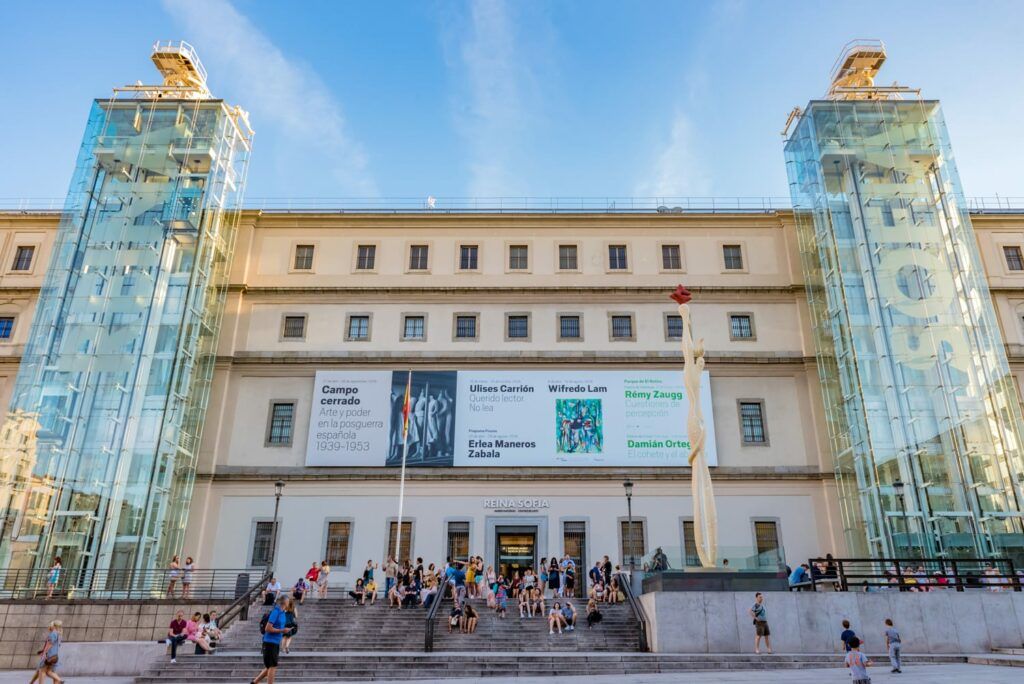
Here are some of the rooms you should hit on a visit:
- Room 202: early Surrealism (Miro and Picabia)
- Room 205: Dali works
- Room 206: Guernica , preparatory works & photos
- Room 209: Dali self-portrait & more Miros
- 1st & 3rd Floor: temporary exhibitions
- 4th Floor: Post-war abstract art
The building is quite large. Indeed, you could easily get lost. If you want to see the highlights without a struggle, I recommend booking a guided tour .
In this guide to the Reina Sofia, I identify the must see masterpieces and give you tips for visiting the museum.
Guide To The Reina Sofia: What To See
Picasso, guernica.
Guernica is the museum’s pièce de résistance and probably the most famous painting in Spain.
It’s massive (over 280 square feet), and you may feel like it’s wrapped around you. The size is part of its raw emotional power.
Picasso’s tortured monochromatic painting was created in a white heat of rage after the Nazis bombed of the town of Guernica in northern Spain. It depicts the horror, misery, and devastation that resulted from the senseless attack.
The 3 hour raid was carried out on General Franco’s orders and more than 2,000 people were massacred on market day. It was a “gift” to Hitler for his birthday, a test of the Luftwaffe’s ability to annihilate cities.
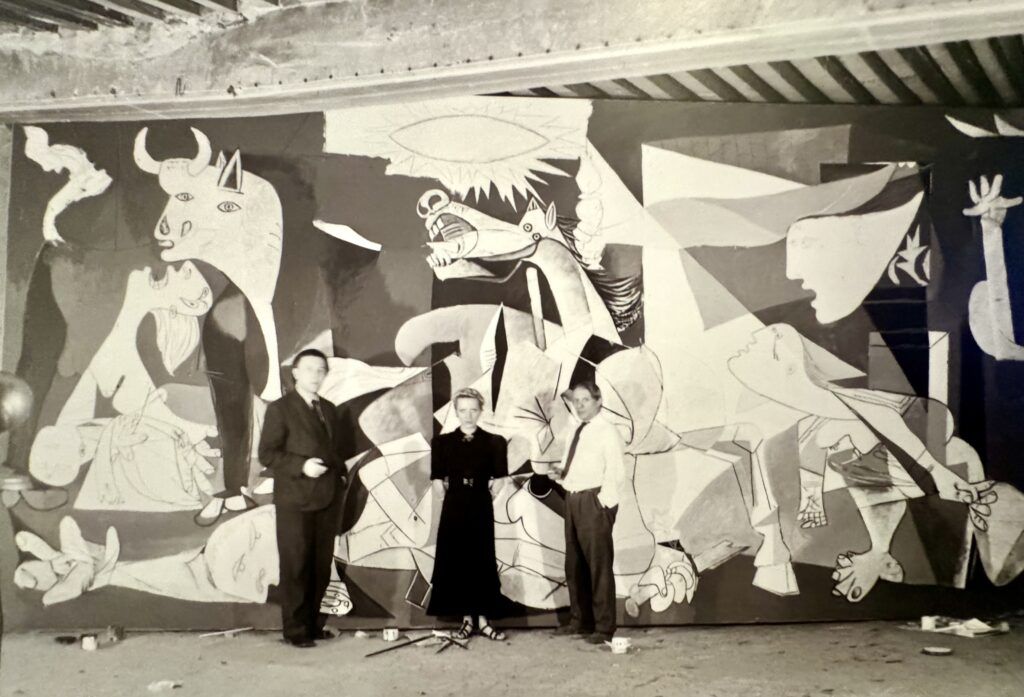
Until the bombing, Picasso hadn’t settled on a subject for his commission for the Spanish Pavilion of the World Fair.
He didn’t usually paint political themes. But his then partner, Surrealist photographer Dora Mara, urged him to capture the horror of war.
Picasso was reluctant at first, saying he would have “terrible problems” with the painting. Nonetheless, as a pacifist, he was “determined to do it … to arm for the war to come.”
The artist succeeded, churning out the greatest anti-war painting ever made. Guernica was an instant success and cemented Picasso’s reputation as the greatest painter of the 20th century.
At first glance, the painting appears to be a chaotic assortment of body parts. There’s death and dying everywhere. Eyes are dislocated, forms are fragmented, mouths are open, and tongues are shaped like daggers.

Art historians have puzzled over the gut wrenching Guernica for decades. Like many of his masterpieces, it’s littered with Picasso’s own problems and preoccupations.
You can easily see the village on the right and people running away in terror.
The dying horse in the center stands for pain and death, but is also an allusion to the horses of the apocalypse. Its head is twisted because of the heat of the bombs.
The bull, a frequent Picasso motif, represents the people of Spain. But the usually powerful creature looks rather impotent and frightened.
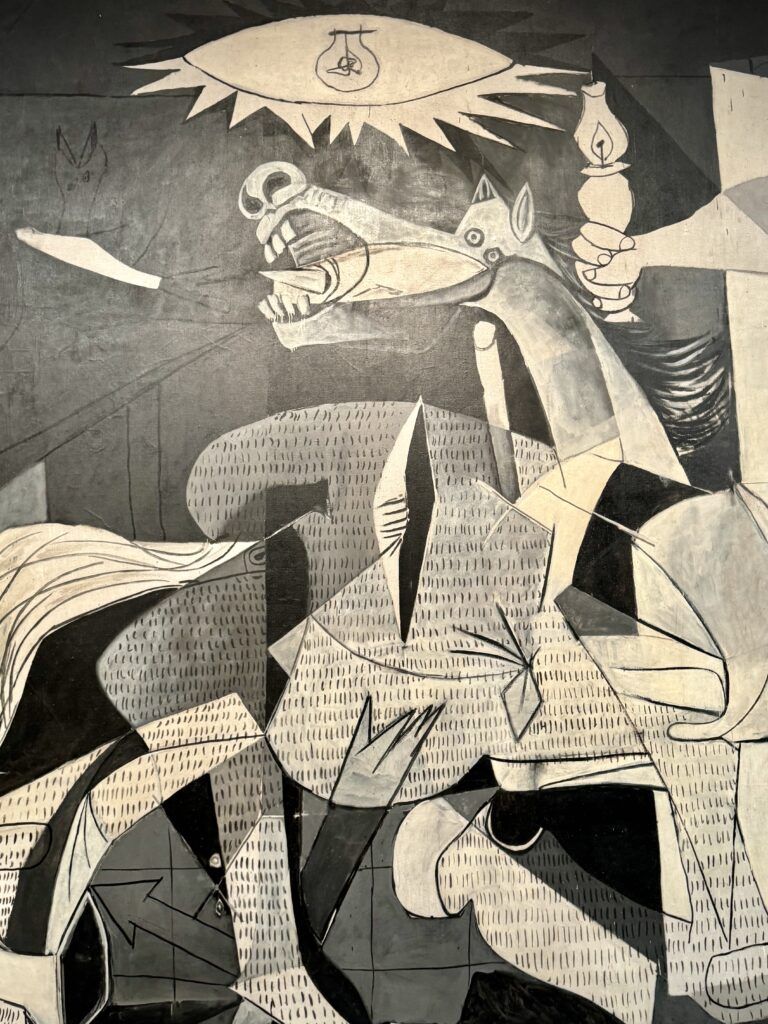
Others have argued that the bull represents the brutality and darkness of the fascist forces. This interpretation would account for why the bull seems unperturbed by the woman shrieking below.
The “weeping woman” is an image of Maar, who Picasso always portrayed as tortured.
In Guernica , she holds a dead child in her arms, like a modern pieta. Her tears seemed wired to her eyes, and she looks up to the sky screaming.
For six months after Guenic a, Picasso painted the weeping woman image obsessively.
The lightbulb is interpreted as an “evil eye” or as technology that brings destruction rather than enlightenment.
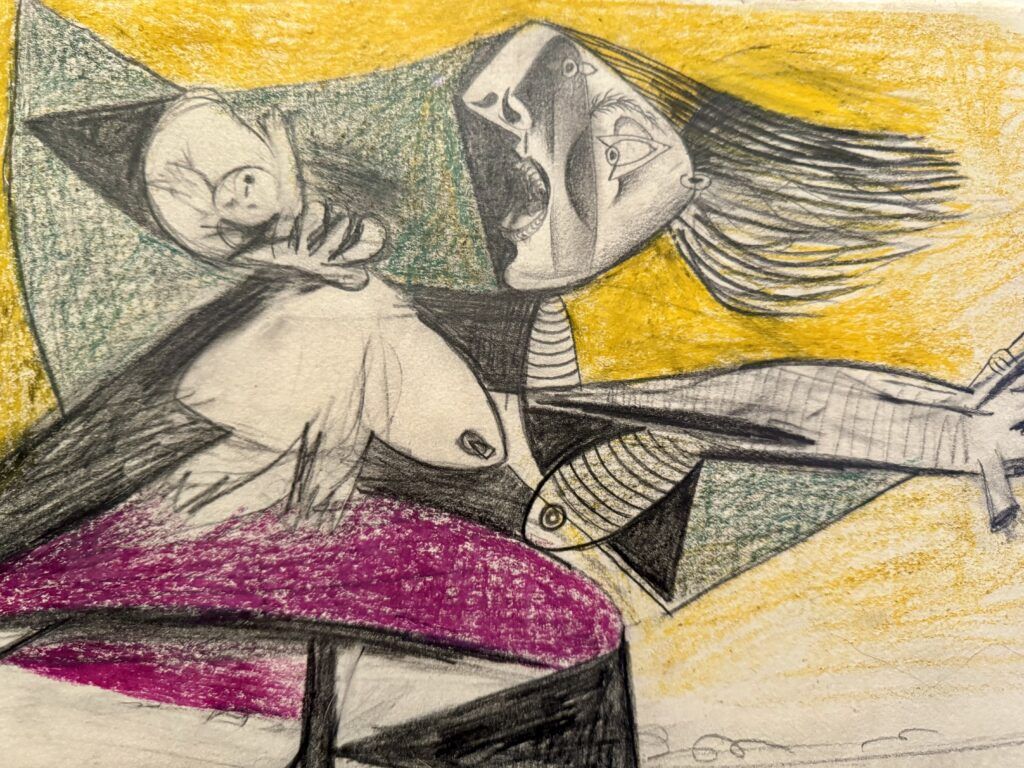
In contrast, the candle held by one of the figures may symbolize hope or the human spirit enduring through the darkness of war.
At the bottom of the composition lies a fallen soldier, dismembered and broken.
He holds a broken sword from which a flower grows. This could symbolize defeat, but also a sliver of hope for peace or regeneration.
One of the best things about the Guernica room is that you can see and feel Picasso’s creative process.
The room is filled with revealing photos of Picasso painting, taken by Maar, and numerous studies the artist created for the painting. In fact, this was the first photographic record of the creation of a modern artwork from start to finish.
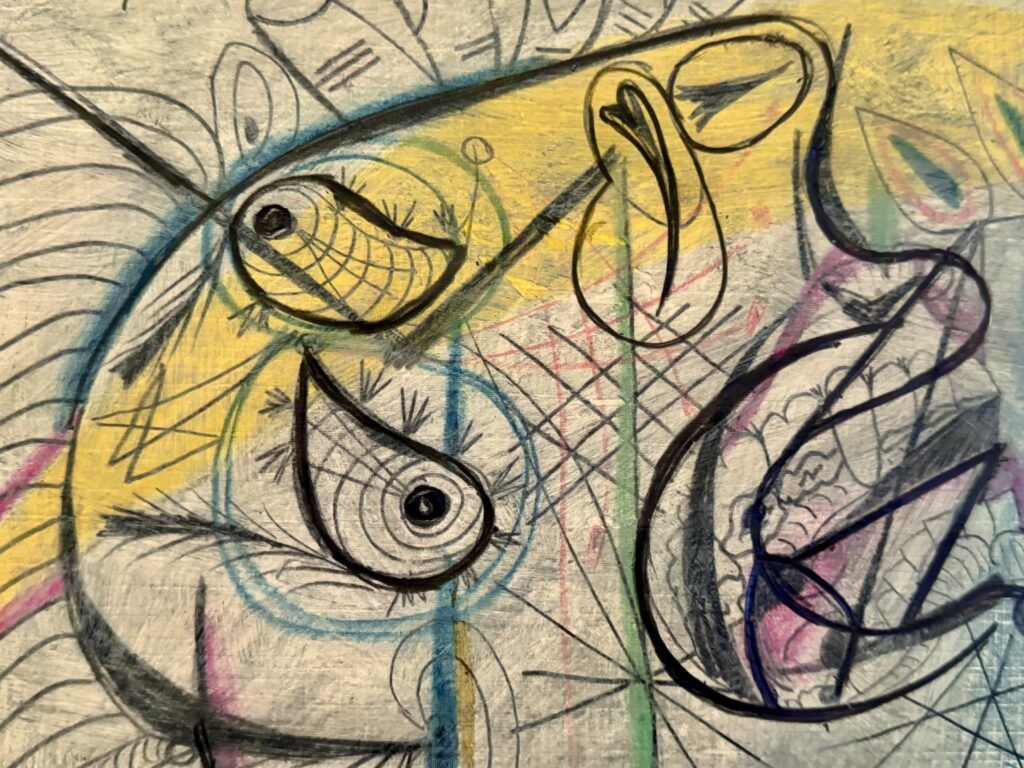
After the World Fair, Guernica went on an international tour and was returned to Picasso.
He refused to have it on Spanish soil until the country was a republic. So, Picasso lent it to the Museum of Modern Art in NYC, where it stayed for decades.
It wasn’t until 1981, after Franco’s death in 1975, that Guernica finally returned from exile.
Picasso had wanted the painting in the Prado in the same room as Velazquez’ Les Meninas and Goya’s The Third of May . But, because it was a work of modern art, it went to the Reina Sofia.
Since its debut in 1937, Guernica has become a timeless classic representing the horror of all wars.
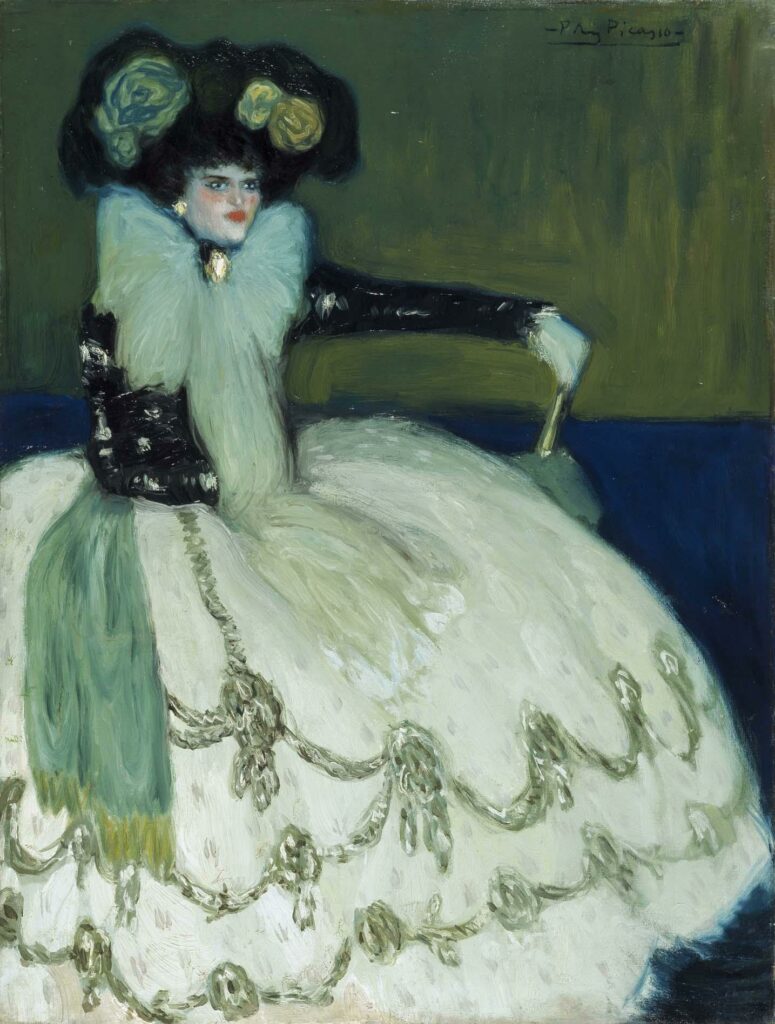
Other Picasso Paintings
The museum has quite a number of Picasso paintings.
There are works from many of his different periods — Blue Period, Cubism, Surrealism, and Classicism. Picasso was an artist that never stopped inventing.
The bulk of the museum’s artworks are from his Cubist period. Picasso deconstructed objects and figures into geometric forms, basically abandoning traditional perspectives of representation.
You can see pieces from his analytic cubism and synthetic cubism period. The earlier analytic style break down objects into fragmentary images, whereas the synthetic style flattened out the images.
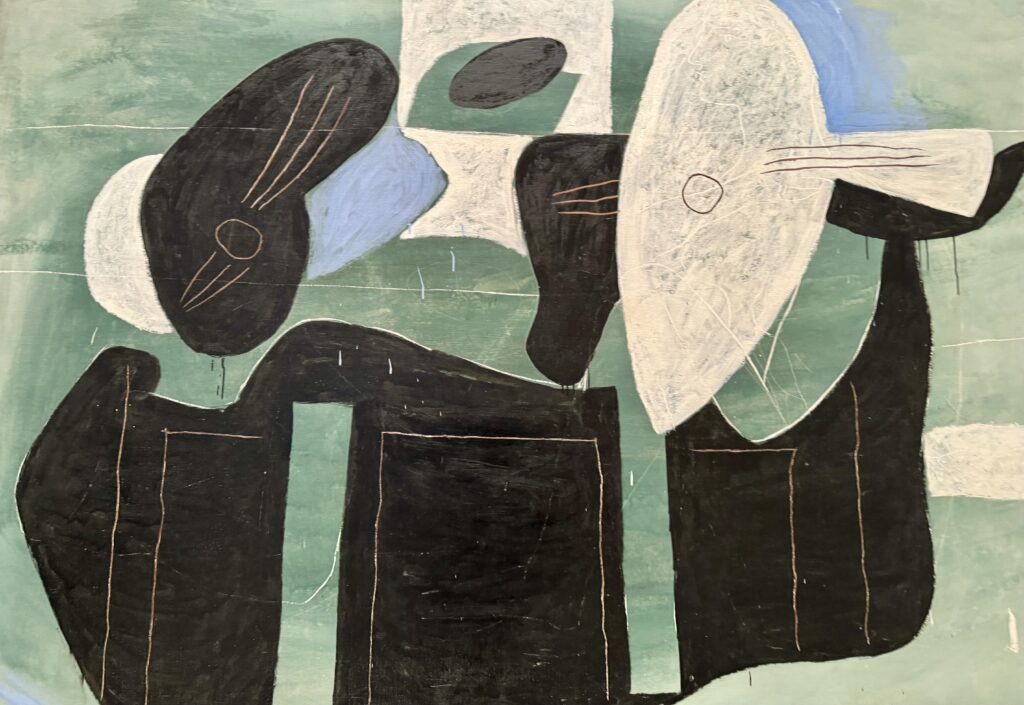
Juan Gris Paintings
The museum has an important collection of paintings by Juan Gris. Though not as well known as Picasso and Braque, he was the third key figure in the development of Cubism.
Gris brought a distinctive approach to Cubism.
He had a precise and methodical style. It incorporated clearer shapes, an acrobatic lightness, and brighter colors. Instead of taking color out — like the other Cubists — he put color in.
Gris’ paintings include still lifes, portraits, musical instruments, and scenes with a level of complexity and harmony that set his work apart from that of his contemporaries.
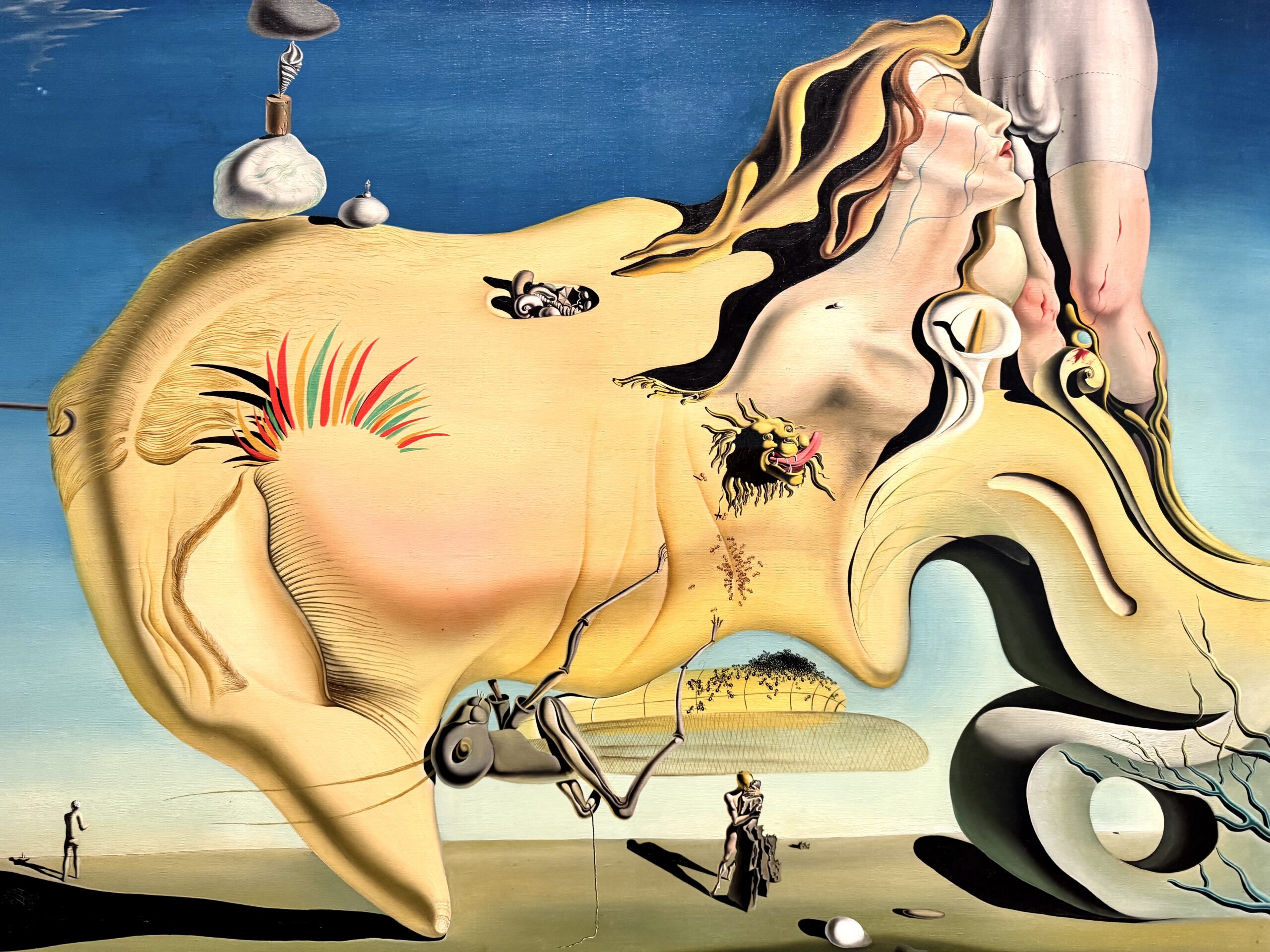
Dali, Face of the Great Masturbator
When you think of Salvador Dalí, his flamboyant character and signature waxed mustache instantly come to mind.
Dalí was a self-described eccentric who reveled in the spotlight, enjoying the allure of wealth and fame.
His art is as remarkable and striking as his personality. He was a master of Surrealism.
Dalí delved into the realm of dreams and the subconscious to create vivid, bizarre landscapes that challenge our perceptions of reality.
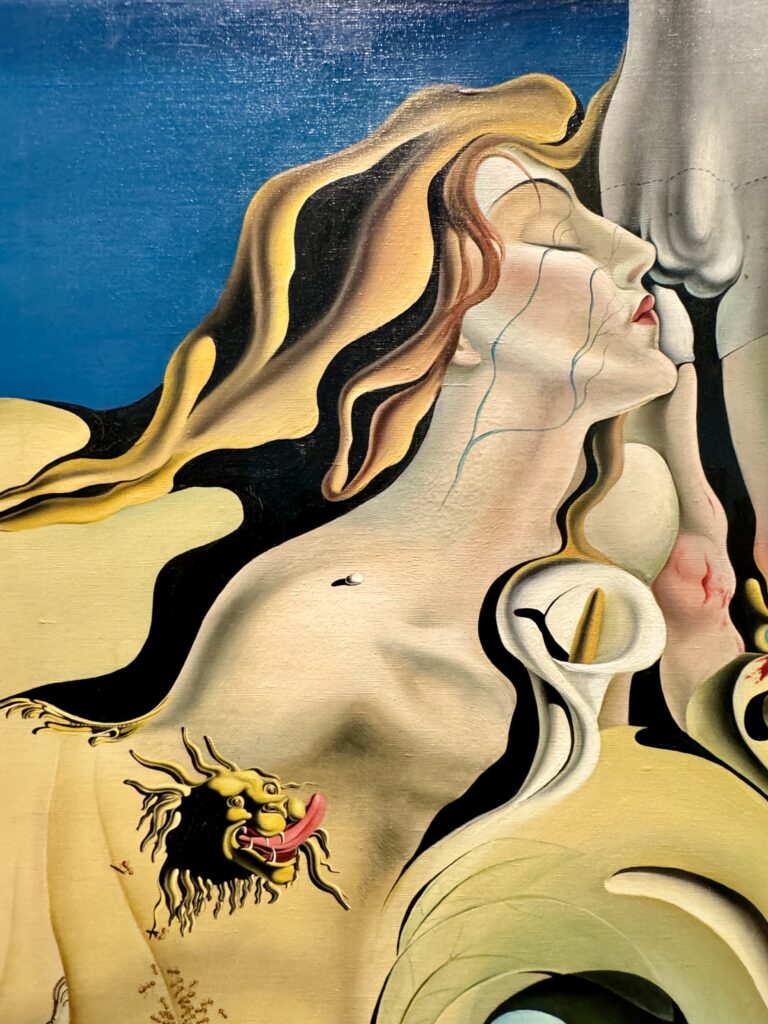
The Face of the Great Masturbator is one of Dalí’s most famous paintings.
It’s full of complex symbolic imagery and fantasy, reflecting Dalí’s obsession and anxieties over death, decay, and sex.
You see a distorted face, probably a self-portrait or personification of Dali, that seems shunted into the landscape. Eyelashes symbolize seduction. Ants and insects represent decay and Dali’s disgust with sex.
The shells for ears symbolize his father’s voice.
The hook at the top of the head means he was “hooked” by Gala. Pieces of stone on the head represent his guilt over failing to give her a sex life.
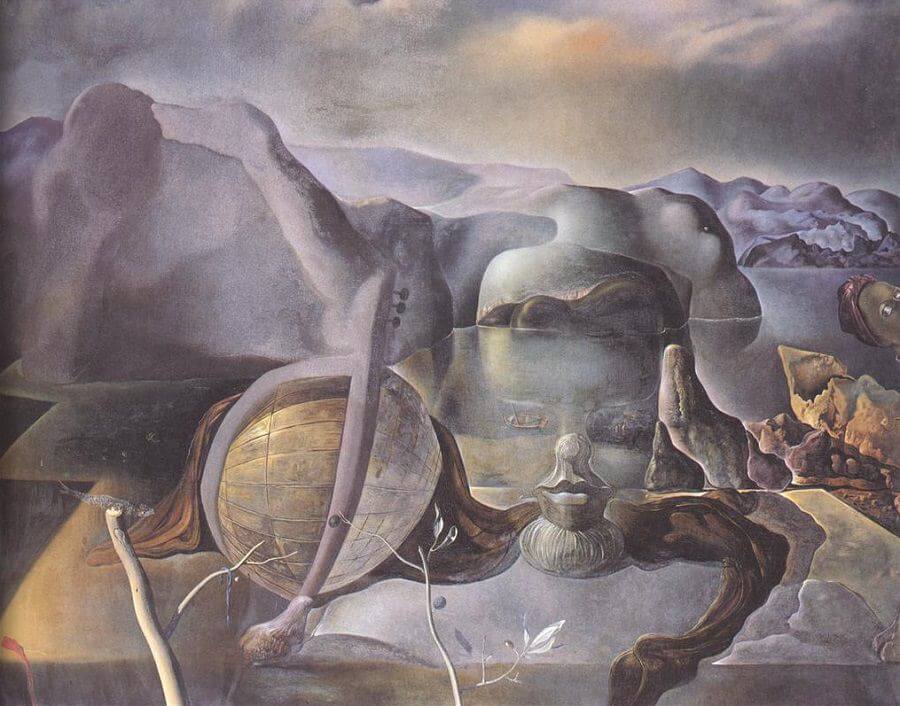
Dali, Endless Engima
Another ambiguous Dali work in the museum is Endless Enigma.
It’s a painting that reflects his fascination with double images, where one set of images forms another distinct set of images when viewed differently.
There are six different images that overlap and form what Dali called “imminent metamorphoses” — whereby one object becomes another object.
You can see a dog, a boat, a fruit dish, a horse, a person’s for, and a recline man.
Another of Dali’s double image paintings in the museum is The invisible Man . The “man” is made of up yellow clouds, ruined architecture, and a waterfall.
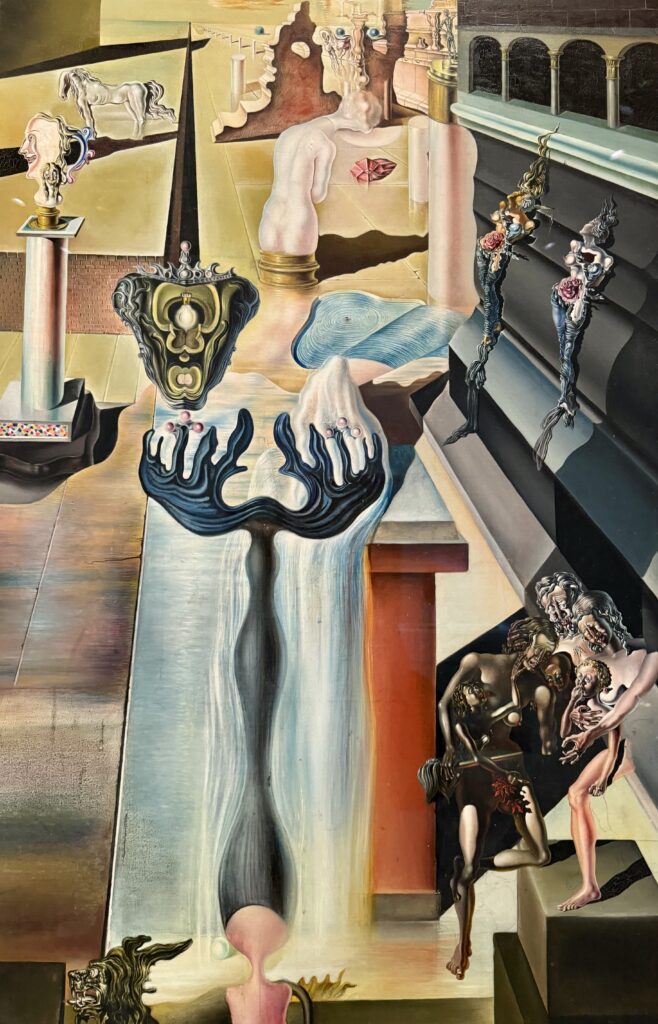
Rene Magritte, Pink Bells, Tattered Skies
Rene Magritte was another key figure in there Surrealist movement, but with a very different style than Dali.
His artwork is witty and subverts the laws of nature. Magritte plays with ordinary objects in an unusual context, forcing the viewer to reconsider what they see and question their perception of reality.
Pink Bells, Tattered Skies is part of his Empire of Light series. In the painting, half the canvas is filled with bells and half is filled with clouds. Both are recurring Magritte motifs.
The bells float in the air, free of their weight and function. The fluffy clouds float effortlessly as well. The chromatic contrast adds to the feeling of unease.
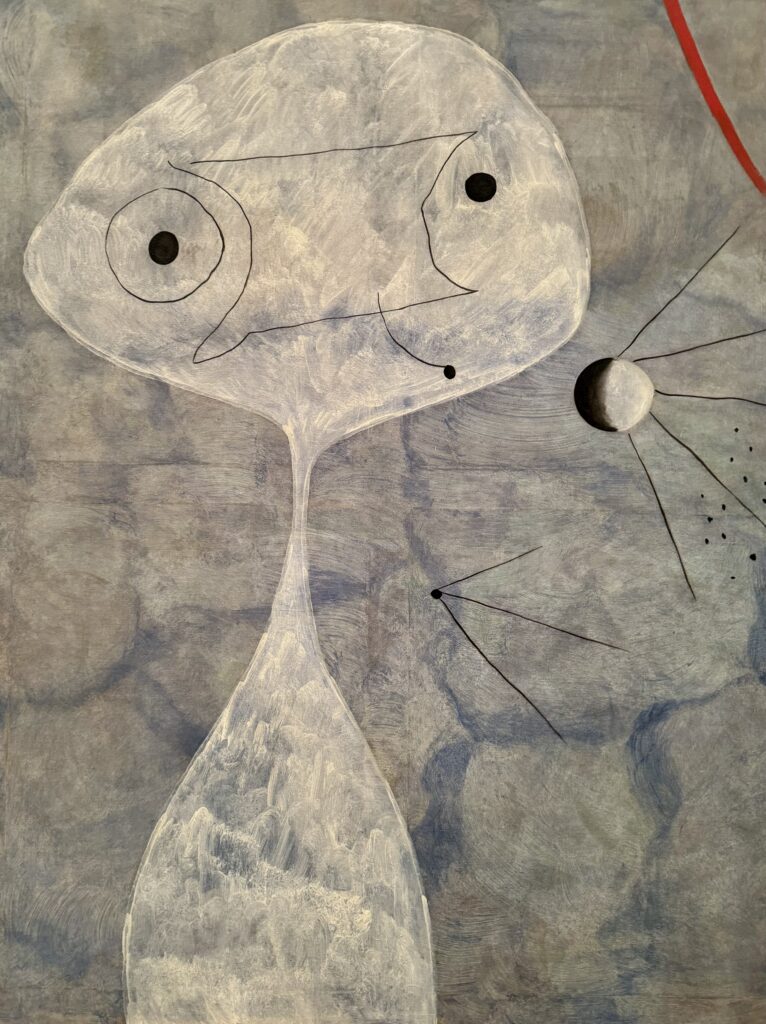
Miro Paintings
The art of Joan Miró defies any straightforward classification.
He’s often linked with the Surrealist movement, though he never officially joined it. He was a pioneer of automatism, which is a creative method for accessing the unconscious mind.
Miró’s oeuvre is marked by a relentless pursuit of innovation and magical, dreamlike abstraction. Similar to Dalí, Miró balanced Surrealism’s embrace of spontaneity and automatism with meticulous planning and precision edges.
Man with a Pipe was created when Miro was evolving toward Surrealism. The figure, drawn in a simplified way, is almost part of the invented space.
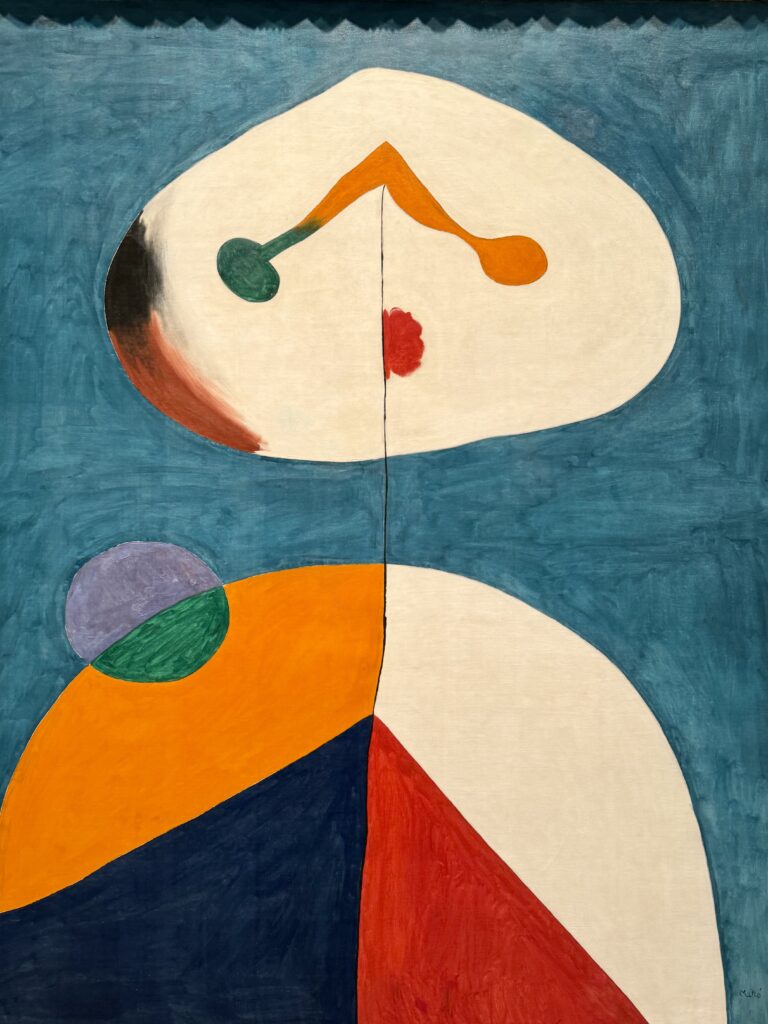
In The Red Spot , Miro abstract shapes and forms that suggest living organisms or natural elements, without directly imitating them.
Probably the most important Miro painting at the Reina Sofia is Snail, Woman, Flower, Star .
It’s part of a series the artist called “wild paintings.” The painting expressed the artist’s fear at the rise of fascism.
It’s a dreamlike composition that reflects his interest in the natural world, the feminine form, and celestial bodies, all rendered through his abstract and biomorphic lens.
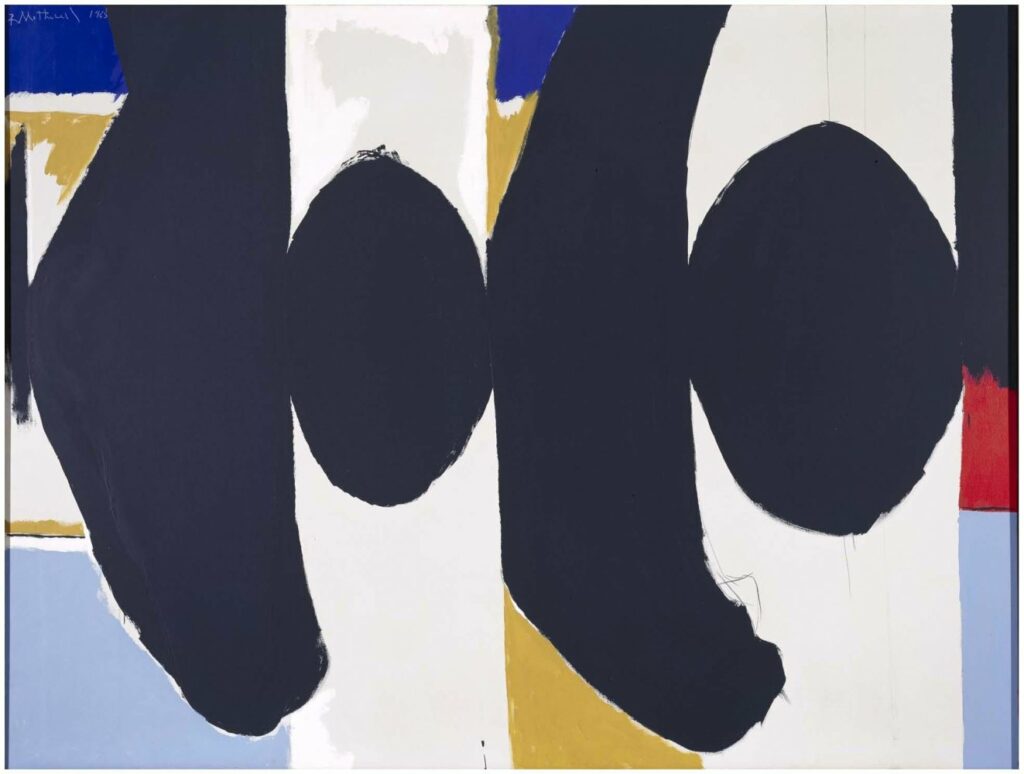
Post War Abstraction
On the fourth floor, you’ll find artworks from artists on both sides of the Atlantic, all with a post war theme.
You’ll find abstract pieces by Hans Hartung, Antoni Tapies, Angel Ferrant, and later Surrealist works by Dali and Miro.
American artists represented include Clyfford Still, Robert Motherwell, and Mark Rothko.
From a historical point of view, you’ll also find the political films of Isidore Isou and Maurice Lemaitre. In Room 404, you’ll see photos of Spain from the 1950s.
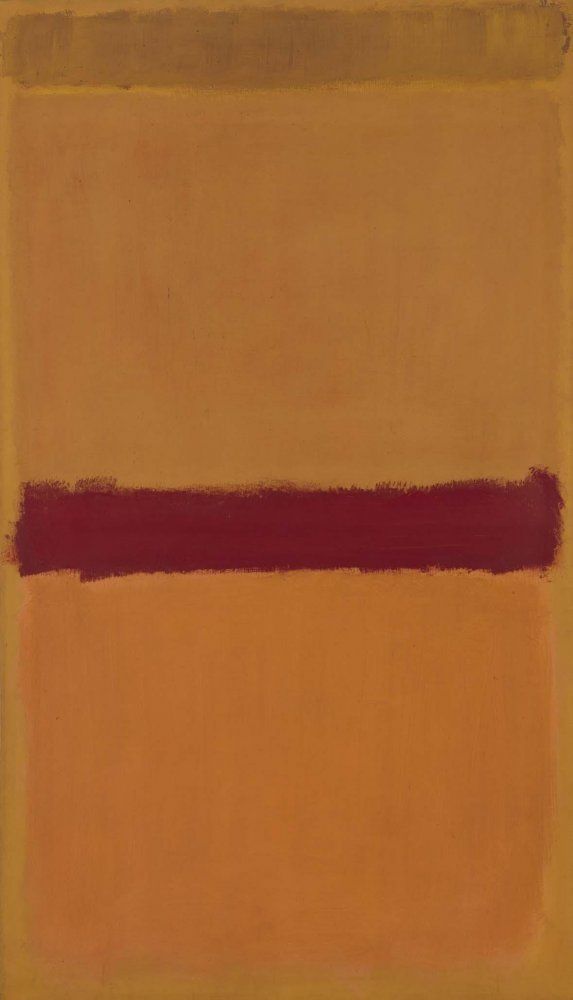
Roy Lichtenstein, Brushstroke
As you enter the museum courtyard, the first artwork you’ll see is Lichtenstein’s famous Brushstroke .
Lichtenstein was a prominent American pop artist. Like Andy Warhol , he sought to blur the boundaries between “high” art and popular culture.
Lichtenstein is best known for his comic strip-inspired paintings, and was particularly fascinated with consumerism.
But, beginning in the 1980s, he adopted the image of the brushstroke into a monumental sculpture.
It’s a parody of the act of painting, questioning the authenticity of art in an era dominated by mass media and consumer culture. It was a poke in the eye toward the purported deep meaning of Abstract Expressionist paintings.
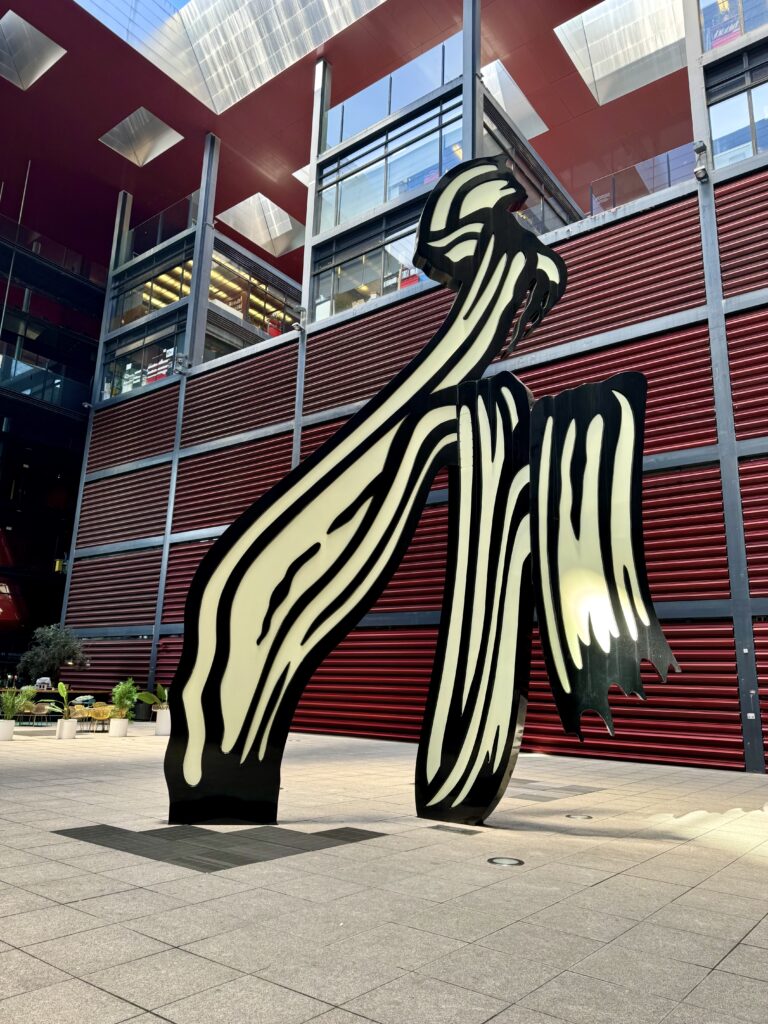
Practical Guide & Tips For The Reina Sofia
Address : Calle de Santa Isabel, 52, Centro
Hours : Open daily, except closed Tuesday, from 10:00 am to 9:00 pm.
Tickets are 12 euros.
Click here to pre-book a skip the line ticket, which you’ll want to do to avoid long lines. You can also buy a combination ticket for the Reina Sofía, the Thyssen-Bornemisza, and the Prado.
The audio guide is 4.50 euros. If you’re not on a tour, I would definitely get one. There is almost no informational signage in the museum.
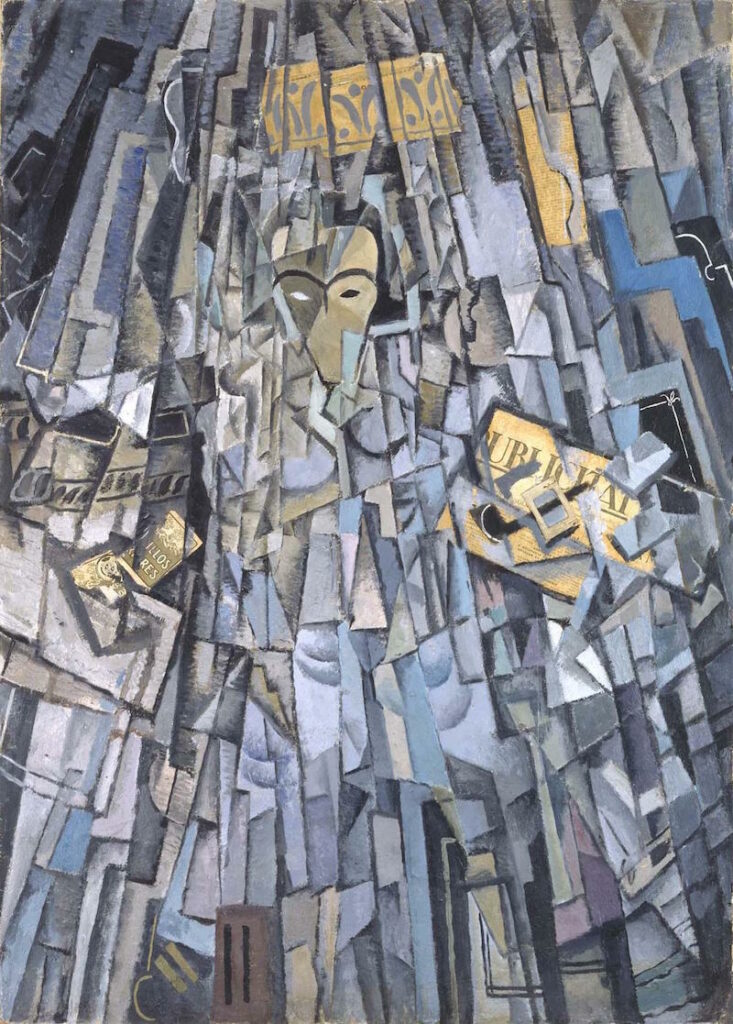
The museum is free of charge on Wednesdays to Mondays (closed Tuesdays) in the evening from 7:00 pm to 9:00 pm, and Sundays from 1:30 pm to 9:00 pm.
Expect crowds at these times. But it won’t be terrible. You may have to wait in line for 30 minutes or so, unless it’s summer.
The museum does allow non-flash photography, which made me happy. Such a relief not to hear guards yell “no foto!” Previously, until September 2023, no photograph was allowed at all in the museum.
I would plan to budget 2-3 hours to see the 2nd and 4th floors, more if you want to see the temporary exhibitions. If you’re pressed for time, stick to the 2nd floor for the most famous masterpieces.
There are lockers with a € 1 deposit near the entrance to store bags.
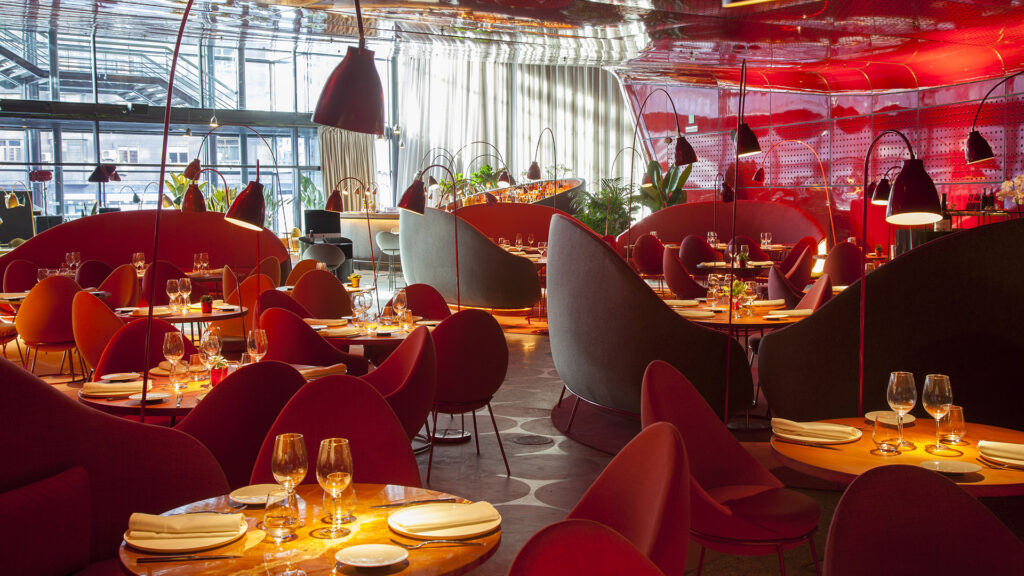
The Reina Sofia has a lovely restaurant named NuBel. The name is a riff on the museum’s architect Jean Nouvel. NuBel translates roughly to beautiful cloud.
The restaurant is simply stunning and sometimes hosts live music. You can get brunch, tapas, or have afternoon tea.
Is the Reina Sofia Worth Visiting?
The Reina Sofia is worth visiting just to see Guernica and its pairing with the Picasso studies and photos. It’s overwhelming and powerful. If you like Surrealism, you’re also in for a treat.
However, a quibble. The Reina Sofia bills itself as the modern art museum in Madrid. I think the Thyssen-Bornemisza Museum , another part of the “Golden Triangle of Art,” is a far superior museum and beats it on the Modernism score.
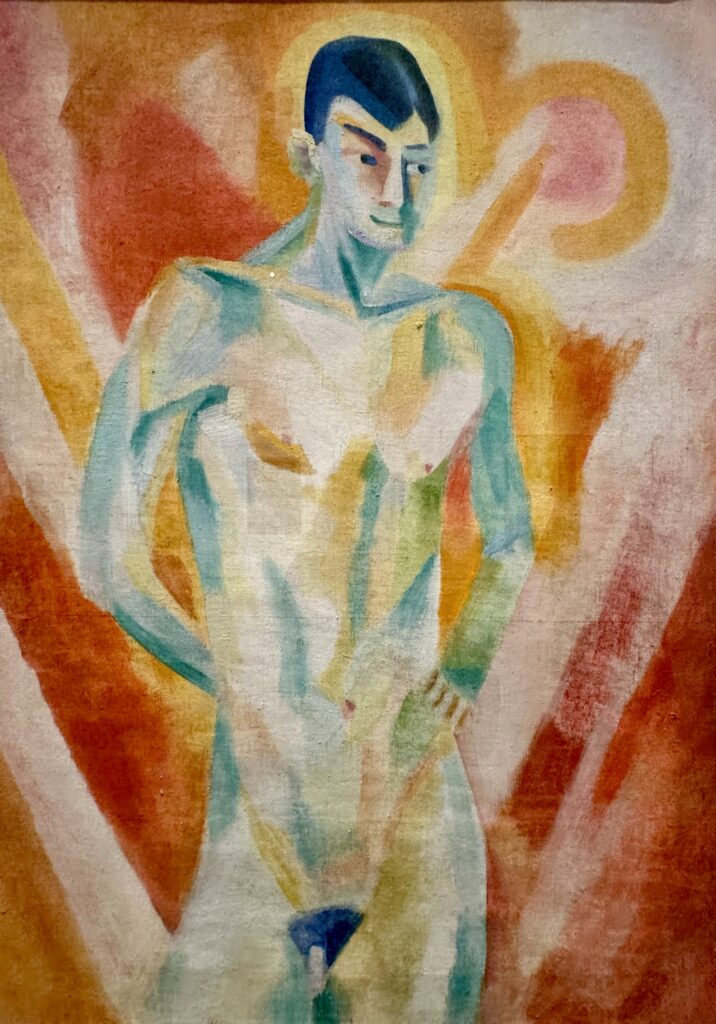
The Thyssen has an absolutely splendid array of modern art, with all the “isms” on display. And, unlike the Reina Sofia, it’s not just limited to Spanish artists.
My only other slight gripe is the museum is disorganized, with a labyrinthian layout. There is no map or paper floor plan to help you navigate.
There’s also no explanatory panels. So you’ll need this Reina Sofia guide to know what to see!
I hope you’ve enjoyed my guide to the Reina Sofia. You may find the other related travel guides useful:
- 10 day itinerary for Andalusia
- Most Beautiful Towns in Andalusia
- 3 day itinerary for Seville
- 3 day itinerary for Barcelona
- 2 day Itinerary for Madri d
- 33 secret towns in Spain
- 10 day itinerary from Madrid to Seville
- 10 day itinerary from Barcelona to Bilbao
- 10 day itinerary for Basque Spain
- 2 day Itinerary for Bilbao
- 1 day in Toledo itinerary
Pin it for later.
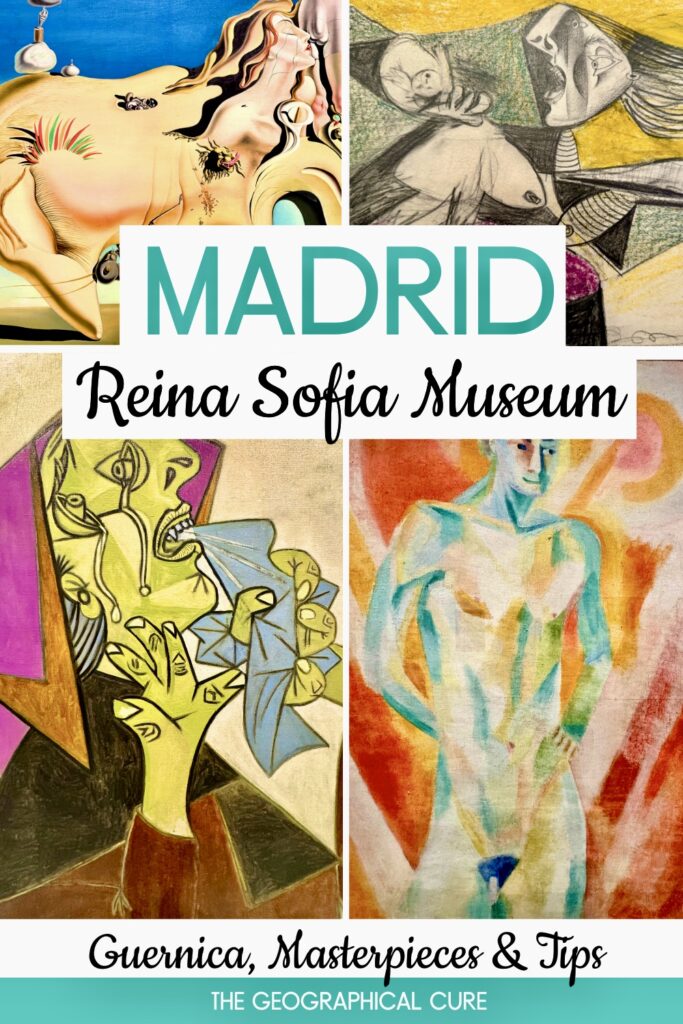
Leave a Comment Cancel reply
Save my name, email, and website in this browser for the next time I comment.
Last Updated on March 29, 2024 by Leslie Livingston
Reina Sofia Museum in Madrid Guided Tour for Kids & Families

- Kid-friendly tour
- Private tour
- Art expert tour
- Entrance fees
- Entry/Admission - Museo Nacional Centro de Arte Reina Sofía
- Food & drinks
- Museo Nacional Centro de Arte Reina Sofía, C. de Sta. Isabel, 52, Centro, 28012 Madrid, Spain Your tour will start in front of the the Reina Sofia Museum, where yo will meet you guide, who will be holding on a sign with your name on.
- Wheelchair accessible
- Stroller accessible
- Near public transportation
- Transportation is wheelchair accessible
- Surfaces are wheelchair accessible
- Most travelers can participate
- This is a private tour/activity. Only your group will participate
- For a full refund, cancel at least 24 hours in advance of the start date of the experience.
- Museo Nacional Centro de Arte Reina Sofía

Similar experiences

- You'll start at Museo Nacional Centro de Arte Reina Sofía C. de Sta. Isabel, 52, Centro, 28012 Madrid, Spain Your tour will start in front of the the Reina Sofia Museum, where yo will meet you guide, who will be holding on a sign with your name on. See address & details
- 1 Museo Nacional Centro de Arte Reina Sofia Stop: 3 hours - Admission included You will admire the greatest masterpieces in the collections of the Reina Sofia Museum. Our child-friendly guide will ensure that your children embark on a thrilling educational journey and have lots of fun learning about art and culture. Read more
- You'll return to the starting point

- Myles D 0 contributions 5.0 of 5 bubbles Museo del Prado fantastico! Our guide Fernando was muy fabuloso. His knowledge of history of Spanish and European art history was outstanding and we learned so much. Fernando took us deep into the paintings and we gained a great appreciation for the Spanish masters like Goya and Valezquez and their close ties with the Italian Renaissance painters. Bravo Fernando! Read more Written June 20, 2021
More to explore in Madrid

Buy it with

Reina Sofia Museum in Madrid Guided Tour for Kids & Families provided by Raphael Tours & Events
Popular currencies
More currencies, reina sofia museum guided tour.

- Instant confirmation
- Mobile ticket
Take a guided tour of one of the most renowned art museums in Europe, Reina Sofia, and see famous works of artists such as Dali, Picasso & Joan Miró.
Explore the world-famous Reina Sofia Museum in Madrid, showcasing Picasso, Dalí, and Miró on a guided tour.
Immerse in 20th-century art movements, with permanent collections like Avant-garde Territories. City, Architecture and Magazines , and Apparatus 92. Can History Be Rewound? .
Intriguing temporary exhibitions include Antoni Tàpies: The Practice of Art and What They Saw: Historical Photobooks by Women, 1843–1999 .
This ticket gives you the option to choose an informative tour in either English or Spanish, or a guide that speaks both!
Fun fact: The museum is housed in a historic 18th-century building that was originally a hospital, known as the General Hospital of Madrid.
Guided tour of Reina Sofia Museum with entry
Expert English and/or Spanish-speaking guide
Cancellation policy
You can cancel these tickets up to 24 hours before the experience begins and get a full refund.
Ratings & Reviews
Your experience
A treasure trove in madrid.
One of the most important modern art museums in the world, the Reina Sofia is primarily dedicated to Spanish Art, with an excellent collection of works by Salvatore Dali, Joan Miró, and Pablo Picasso. Your guide will lead you through the museum, offering insights into the evolution of Spanish art, covering surrealism, modernism, abstractionism, and cubism with notable works from Spanish artists.
Dive deep into art analysis
During this guided tour, you'll encounter the museum's star attraction, Picasso's masterpiece Guernica . Delve into the art's history and significance with a dedicated local expert. Afterward, feel free to explore the museum independently!
Know before you go
What's not allowed.
- Note that the following are not allowed on this tour: large bags, flash photography, tripods.
Accessibility
- Disabled people are welcome as this experience is wheelchair and pram/stroller accessible.
Additional information
Please arrive at the meeting point 15 minutes before your scheduled time.
Photography is allowed in this experience.
Your voucher will be emailed to you instantly.
Display the voucher on your mobile phone with a valid photo ID at the meeting point.
Please arrive at the meeting point 15 minutes before the scheduled time of your tour to avoid any delays.
Meeting point
- Please check your final voucher for the meeting point details and specific instructions.
Why Headout?
Similar experiences you'd love.

Top things to do in Madrid

Browse By Themes
Nearby cities to explore.

World at your tap.

We've served 25 million+ guests and we are here for you
25 million +
In the Media
24 x 7 Help Center
- Preplanned tours
- Daytrips out of Moscow
- Themed tours
- Customized tours
- St. Petersburg
Moscow Metro
The Moscow Metro Tour is included in most guided tours’ itineraries. Opened in 1935, under Stalin’s regime, the metro was not only meant to solve transport problems, but also was hailed as “a people’s palace”. Every station you will see during your Moscow metro tour looks like a palace room. There are bright paintings, mosaics, stained glass, bronze statues… Our Moscow metro tour includes the most impressive stations best architects and designers worked at - Ploshchad Revolutsii, Mayakovskaya, Komsomolskaya, Kievskaya, Novoslobodskaya and some others.
What is the kremlin in russia?
The guide will not only help you navigate the metro, but will also provide you with fascinating background tales for the images you see and a history of each station.
And there some stories to be told during the Moscow metro tour! The deepest station - Park Pobedy - is 84 metres under the ground with the world longest escalator of 140 meters. Parts of the so-called Metro-2, a secret strategic system of underground tunnels, was used for its construction.
During the Second World War the metro itself became a strategic asset: it was turned into the city's biggest bomb-shelter and one of the stations even became a library. 217 children were born here in 1941-1942! The metro is the most effective means of transport in the capital.
There are almost 200 stations 196 at the moment and trains run every 90 seconds! The guide of your Moscow metro tour can explain to you how to buy tickets and find your way if you plan to get around by yourself.
Moscow Metro Tour
- Page active

Description
Moscow metro private tours.
- 2-hour tour $87: 10 Must-See Moscow Metro stations with hotel pick-up and drop-off
- 3-hour tour $137: 20 Must-See Moscow Metro stations with Russian lunch in beautifully-decorated Metro Diner + hotel pick-up and drop off.
- Metro pass is included in the price of both tours.
Highlight of Metro Tour
- Visit 10 must-see stations of Moscow metro on 2-hr tour and 20 Metro stations on 3-hr tour, including grand Komsomolskaya station with its distinctive Baroque décor, aristocratic Mayakovskaya station with Soviet mosaics, legendary Revolution Square station with 72 bronze sculptures and more!
- Explore Museum of Moscow Metro and learn a ton of technical and historical facts;
- Listen to the secrets about the Metro-2, a secret line supposedly used by the government and KGB;
- Experience a selection of most striking features of Moscow Metro hidden from most tourists and even locals;
- Discover the underground treasure of Russian Soviet past – from mosaics to bronzes, paintings, marble arches, stained glass and even paleontological elements;
- Learn fun stories and myths about Coffee Ring, Zodiac signs of Moscow Metro and more;
- Admire Soviet-era architecture of pre- and post- World War II perious;
- Enjoy panoramic views of Sparrow Hills from Luzhniki Metro Bridge – MetroMost, the only station of Moscow Metro located over water and the highest station above ground level;
- If lucky, catch a unique «Aquarelle Train» – a wheeled picture gallery, brightly painted with images of peony, chrysanthemums, daisies, sunflowers and each car unit is unique;
- Become an expert at navigating the legendary Moscow Metro system;
- Have fun time with a very friendly local;
- + Atmospheric Metro lunch in Moscow’s the only Metro Diner (included in a 3-hr tour)
Hotel Pick-up
Metro stations:.
Komsomolskaya
Novoslobodskaya
Prospekt Mira
Belorusskaya
Mayakovskaya
Novokuznetskaya
Revolution Square
Sparrow Hills
+ for 3-hour tour
Victory Park
Slavic Boulevard
Vystavochnaya
Dostoevskaya
Elektrozavodskaya
Partizanskaya
Museum of Moscow Metro
- Drop-off at your hotel, Novodevichy Convent, Sparrow Hills or any place you wish
- + Russian lunch in Metro Diner with artistic metro-style interior for 3-hour tour
Fun facts from our Moscow Metro Tours:
From the very first days of its existence, the Moscow Metro was the object of civil defense, used as a bomb shelter, and designed as a defense for a possible attack on the Soviet Union.
At a depth of 50 to 120 meters lies the second, the coded system of Metro-2 of Moscow subway, which is equipped with everything you need, from food storage to the nuclear button.
According to some sources, the total length of Metro-2 reaches over 150 kilometers.
The Museum was opened on Sportivnaya metro station on November 6, 1967. It features the most interesting models of trains and stations.
Coffee Ring
The first scheme of Moscow Metro looked like a bunch of separate lines. Listen to a myth about Joseph Stalin and the main brown line of Moscow Metro.
Zodiac Metro
According to some astrologers, each of the 12 stops of the Moscow Ring Line corresponds to a particular sign of the zodiac and divides the city into astrological sector.
Astrologers believe that being in a particular zadiac sector of Moscow for a long time, you attract certain energy and events into your life.
Paleontological finds
Red marble walls of some of the Metro stations hide in themselves petrified inhabitants of ancient seas. Try and find some!
- Every day each car in Moscow metro passes more than 600 km, which is the distance from Moscow to St. Petersburg.
- Moscow subway system is the 5th in the intensity of use (after the subways of Beijing, Tokyo, Seoul and Shanghai).
- The interval in the movement of trains in rush hour is 90 seconds .
What you get:
- + A friend in Moscow.
- + Private & customized Moscow tour.
- + An exciting pastime, not just boring history lessons.
- + An authentic experience of local life.
- + Flexibility during the walking tour: changes can be made at any time to suit individual preferences.
- + Amazing deals for breakfast, lunch, and dinner in the very best cafes & restaurants. Discounts on weekdays (Mon-Fri).
- + A photo session amongst spectacular Moscow scenery that can be treasured for a lifetime.
- + Good value for souvenirs, taxis, and hotels.
- + Expert advice on what to do, where to go, and how to make the most of your time in Moscow.
Write your review
The museum is a crossroads of spaces, objects and times: a place where narratives are woven together and stories told, rendering every intersection meaningful as it leads off in one direction or another, turning it into an intense experience of discovery and knowledge. This is why everything that is exhibited, in all its strangeness, all its questions, has to actually touch the visitor’s everyday reality, bringing about a genuine learning experience.
The Museo Reina Sofia’s presentation of its Collection posits a multi-narrative journey, which adopts a definite standpoint and not only keeps the mystery inherent in art alive, but also strengthens resistance towards the single, fixed reading. Traditional genres coexist side by side with photography, film, sound and dance. In addition, the artist has ceased to be the touchstone; the figure of the artist has fragmented and dissolved, allowing any number of expository possibilities to emerge. The same thing occurs with the concept of the ‘masterpiece’, which the Collection recognizes as a valid idea, but not one that automatically has to do with conventional genres, or one that is necessarily structured according to a hierarchy. Instead, the concept embraces artifacts and images such as posters, typographies and publications that stand alongside a work previously considered to be unique and self-contained. In the museum rooms, these examples of juxtaposition and rapprochement are expressed by an interplay of syncopated, contrasting rhythms in an attempt to communicate to the visitor the richness and complexity of certain stories that will always need to be told.
The same idea applies to the way the collection is presented on the museum website: a multiple approach on a number of levels, recreating not only the various narratives of the exhibition rooms, but also the galaxies of concepts that interrelate across the Collection, regardless of era. Finally, there is the selection of a number of artists and works chosen using criteria that go beyond the importance of the artist, the genre or how the piece was executed. The organization of all this (an ongoing process) renders the typical contemporary art categorizations unusable, and instead seeks to offer more flexible solutions, customized to the specifics of each individual piece.
The presentation of the Collection on the museum website is a major strategic project in this new phase at the Museo Reina Sofía, and is directly linked to the implementation of a new database updating all the department’s organizational systems. It is the result of three years of hard work, involving absolute commitment from the entire staff.
Due to conservation or exhibition loans, some of the works in this selection may not be on show in the galleries.

Artworks of the visit

José Solana (José Gutiérrez Solana)
La tertulia del café de pombo (the gathering at the café de pombo).

Juan Gris (José Victoriano González Pérez)
La fenêtre ouverte (open window).

Pablo Picasso (Pablo Ruiz Picasso)
Monument aux espagnols morts pour la france (monument to the spaniards who died for....

Maurice Lemaître
Le film est déjà commencé (has the film started yet).

Jean Dubuffet
Sol terreux (earthy soil).

André Cadere
Barre de bois cubique (cubic bar of wood).
- siguiente ›
Authors of the visit
- Alberto (Alberto Sánchez)
- Alexanco, José Luis
- Barradas, Rafael (Rafael Pérez Giménez)
- Braque, Georges
- Brassaï (Gyula Halász)
- Broodthaers, Marcel
- Cadere, André
- Centelles, Agustí
- Criado, Nacho
- Dalí, Salvador
- Domínguez, Óscar
- Dubuffet, Jean
- Fabro, Luciano
- Fahlström, Öyvind
- Ferrer, Esther
- Gallizio, Pinot
- González, Julio
- Gordillo, Luis
- Guerrero, José
- Guston, Philip
- Juan Gris (González Pérez, José Victoriano)
- Kelley, Mike
- Lemaître, Maurice
- Lipchitz, Jacques
- Motherwell, Robert
- Muntadas, Antoni
- Oiticica, Hélio
- Oteiza, Jorge
- Pablo, Luis de
- Palencia, Benjamín
- Pérez Villalta, Guillermo
- Picabia, Francis
- Picasso, Pablo (Pablo Ruiz Picasso)
- Pistoletto, Michelangelo
- Quejido, Manolo
- Richter, Gerhard
- Rosso, Medardo
- Santos, Ángeles
- Saura, Antonio
- Smith, Eugene
- Solana, José (José Gutiérrez Solana)
- Tàpies, Antoni
- Trillo, Miguel
- Val del Omar, José
- Valverde, Joaquín
- Wojnarowicz, David
- Articles >
The Moscow Metro Museum of Art: 10 Must-See Stations
There are few times one can claim having been on the subway all afternoon and loving it, but the Moscow Metro provides just that opportunity. While many cities boast famous public transport systems—New York’s subway, London’s underground, San Salvador’s chicken buses—few warrant hours of exploration. Moscow is different: Take one ride on the Metro, and you’ll find out that this network of railways can be so much more than point A to B drudgery.
The Metro began operating in 1935 with just thirteen stations, covering less than seven miles, but it has since grown into the world’s third busiest transit system ( Tokyo is first ), spanning about 200 miles and offering over 180 stops along the way. The construction of the Metro began under Joseph Stalin’s command, and being one of the USSR’s most ambitious building projects, the iron-fisted leader instructed designers to create a place full of svet (radiance) and svetloe budushchee (a radiant future), a palace for the people and a tribute to the Mother nation.
Consequently, the Metro is among the most memorable attractions in Moscow. The stations provide a unique collection of public art, comparable to anything the city’s galleries have to offer and providing a sense of the Soviet era, which is absent from the State National History Museum. Even better, touring the Metro delivers palpable, experiential moments, which many of us don’t get standing in front of painting or a case of coins.
Though tours are available , discovering the Moscow Metro on your own provides a much more comprehensive, truer experience, something much less sterile than following a guide. What better place is there to see the “real” Moscow than on mass transit: A few hours will expose you to characters and caricatures you’ll be hard-pressed to find dining near the Bolshoi Theater. You become part of the attraction, hear it in the screech of the train, feel it as hurried commuters brush by: The Metro sucks you beneath the city and churns you into the mix.
With the recommendations of our born-and-bred Muscovite students, my wife Emma and I have just taken a self-guided tour of what some locals consider the top ten stations of the Moscow Metro. What most satisfied me about our Metro tour was the sense of adventure . I loved following our route on the maps of the wagon walls as we circled the city, plotting out the course to the subsequent stops; having the weird sensation of being underground for nearly four hours; and discovering the next cavern of treasures, playing Indiana Jones for the afternoon, piecing together fragments of Russia’s mysterious history. It’s the ultimate interactive museum.
Top Ten Stations (In order of appearance)
Kievskaya station.

Kievskaya Station went public in March of 1937, the rails between it and Park Kultury Station being the first to cross the Moscow River. Kievskaya is full of mosaics depicting aristocratic scenes of Russian life, with great cameo appearances by Lenin, Trotsky, and Stalin. Each work has a Cyrillic title/explanation etched in the marble beneath it; however, if your Russian is rusty, you can just appreciate seeing familiar revolutionary dates like 1905 ( the Russian Revolution ) and 1917 ( the October Revolution ).
Mayakovskaya Station
Mayakovskaya Station ranks in my top three most notable Metro stations. Mayakovskaya just feels right, done Art Deco but no sense of gaudiness or pretention. The arches are adorned with rounded chrome piping and create feeling of being in a jukebox, but the roof’s expansive mosaics of the sky are the real showstopper. Subjects cleverly range from looking up at a high jumper, workers atop a building, spires of Orthodox cathedrals, to nimble aircraft humming by, a fleet of prop planes spelling out CCCP in the bluest of skies.
Novoslobodskaya Station

Novoslobodskaya is the Metro’s unique stained glass station. Each column has its own distinctive panels of colorful glass, most of them with a floral theme, some of them capturing the odd sailor, musician, artist, gardener, or stenographer in action. The glass is framed in Art Deco metalwork, and there is the lovely aspect of discovering panels in the less frequented haunches of the hall (on the trackside, between the incoming staircases). Novosblod is, I’ve been told, the favorite amongst out-of-town visitors.
Komsomolskaya Station
Komsomolskaya Station is one of palatial grandeur. It seems both magnificent and obligatory, like the presidential palace of a colonial city. The yellow ceiling has leafy, white concrete garland and a series of golden military mosaics accenting the tile mosaics of glorified Russian life. Switching lines here, the hallway has an Alice-in-Wonderland feel, impossibly long with decorative tile walls, culminating in a very old station left in a remarkable state of disrepair, offering a really tangible glimpse behind the palace walls.
Dostoevskaya Station

Dostoevskaya is a tribute to the late, great hero of Russian literature . The station at first glance seems bare and unimpressive, a stark marble platform without a whiff of reassembled chips of tile. However, two columns have eerie stone inlay collages of scenes from Dostoevsky’s work, including The Idiot , The Brothers Karamazov , and Crime and Punishment. Then, standing at the center of the platform, the marble creates a kaleidoscope of reflections. At the entrance, there is a large, inlay portrait of the author.
Chkalovskaya Station
Chkalovskaya does space Art Deco style (yet again). Chrome borders all. Passageways with curvy overhangs create the illusion of walking through the belly of a chic, new-age spacecraft. There are two (kos)mosaics, one at each end, with planetary subjects. Transferring here brings you above ground, where some rather elaborate metalwork is on display. By name similarity only, I’d expected Komsolskaya Station to deliver some kosmonaut décor; instead, it was Chkalovskaya that took us up to the space station.
Elektrozavodskaya Station

Elektrozavodskaya is full of marble reliefs of workers, men and women, laboring through the different stages of industry. The superhuman figures are round with muscles, Hollywood fit, and seemingly undeterred by each Herculean task they respectively perform. The station is chocked with brass, from hammer and sickle light fixtures to beautiful, angular framework up the innards of the columns. The station’s art pieces are less clever or extravagant than others, but identifying the different stages of industry is entertaining.
Baumanskaya Statio
Baumanskaya Station is the only stop that wasn’t suggested by the students. Pulling in, the network of statues was just too enticing: Out of half-circle depressions in the platform’s columns, the USSR’s proud and powerful labor force again flaunts its success. Pilots, blacksmiths, politicians, and artists have all congregated, posing amongst more Art Deco framing. At the far end, a massive Soviet flag dons the face of Lenin and banners for ’05, ’17, and ‘45. Standing in front of the flag, you can play with the echoing roof.
Ploshchad Revolutsii Station

Novokuznetskaya Station
Novokuznetskaya Station finishes off this tour, more or less, where it started: beautiful mosaics. This station recalls the skyward-facing pieces from Mayakovskaya (Station #2), only with a little larger pictures in a more cramped, very trafficked area. Due to a line of street lamps in the center of the platform, it has the atmosphere of a bustling market. The more inventive sky scenes include a man on a ladder, women picking fruit, and a tank-dozer being craned in. The station’s also has a handsome black-and-white stone mural.
Here is a map and a brief description of our route:
Start at (1)Kievskaya on the “ring line” (look for the squares at the bottom of the platform signs to help you navigate—the ring line is #5, brown line) and go north to Belorusskaya, make a quick switch to the Dark Green/#2 line, and go south one stop to (2)Mayakovskaya. Backtrack to the ring line—Brown/#5—and continue north, getting off at (3)Novosblodskaya and (4)Komsolskaya. At Komsolskaya Station, transfer to the Red/#1 line, go south for two stops to Chistye Prudy, and get on the Light Green/#10 line going north. Take a look at (5)Dostoevskaya Station on the northern segment of Light Green/#10 line then change directions and head south to (6)Chkalovskaya, which offers a transfer to the Dark Blue/#3 line, going west, away from the city center. Have a look (7)Elektroskaya Station before backtracking into the center of Moscow, stopping off at (8)Baumskaya, getting off the Dark Blue/#3 line at (9)Ploschad Revolyutsii. Change to the Dark Green/#2 line and go south one stop to see (10)Novokuznetskaya Station.
Check out our new Moscow Indie Travel Guide , book a flight to Moscow and read 10 Bars with Views Worth Blowing the Budget For
Jonathon Engels, formerly a patron saint of misadventure, has been stumbling his way across cultural borders since 2005 and is currently volunteering in the mountains outside of Antigua, Guatemala. For more of his work, visit his website and blog .

Photo credits: SergeyRod , all others courtesy of the author and may not be used without permission

IMAGES
VIDEO
COMMENTS
Sitio web del Museo Reina Sofía. Información y programación de exposiciones, colección, actividades y proyectos de investigación en red. ... (Guided and self-guided tours) Group visit Reservation in advance needed. Corporate and private visits ... Donations and long term loans at the Museo Reina Sofia; Image Requests; Contact Information ...
Full description. Meet your guide at the Reina Sofía Museum in Madrid. Dedicated to Spanish art, highlights of the museum include super collections of Spain's three greatest 20th-century artists - Pablo Picasso, Salvador Dalí, and Joan Miró. Get a close look at Picasso's "Guernica" mural-sized oil painting, regarded by many as one of the ...
Reina Sofía Museum Guided Tour. Walk into the former hospital building which houses the Reina Sofía led by your guide and marvel at world-renowned 20th-century artists' work such as Juan Gris, Joan Miró, Salvador Dalí and Pablo Picasso.. Learn about Spanish culture and history wandering through the various rooms and the several art movements like modernism, cubism and surrealism.
Guided Tours. Sitio web del Museo Reina Sofía. Información y programación de exposiciones, colección, actividades y proyectos de investigación en red.
The Reina Sofía is one of Madrid's most important museums and houses a fascinating collection of over 21,000 pieces. The main focus of the museum is Modernist 20th-century art, including seminal works by Miró and Salvador Dalí, as well as Picasso's world-changing Guernica. On this 2.5-hour Reina Sofía private tour, we will join a local art ...
Skip-the-line Reina Sofia Museum Madrid Guided Tour - Semi-Private 8ppl Max. 7. Historical Tours. from . $144.41. per adult (price varies by group size) Guided tour of the Reina Sofia Museum in Madrid, entrance fees and pick up at the hotel. 3. Historical Tours. from . $147.14.
A guided tour of Reina Sofia Museum is a great way to enhance your experience and make the most of your visit. With skip-the-line access, an expert guide, and a tailored experience, you can explore the museum's impressive collection of modern art with ease and confidence.
Madrid: Guided Tour of Reina Sofía Museum with Entry Ticket Art enthusiasts will love the chance to explore one of Madrid's top art galleries, the Reina Sofia Museum, with a guide. In a small group you'll tour the museum for about ninety minutes, checking out some of the most famous works (such as Picasso's Guernica) and lesser-known ...
Delve into Spanish art on a guided tour of the Reina Sofia Museum in Madrid. With a group of no more than 30 and a guide whose specialism is art-history, explore the museum's vaulted hallways to discover works by Picasso, Dalí and more. Learn the history behind influential works such as 'El Guernica,' and learn about the modern period of artwork and the differing artistic styles.
Opened in 1986, the Reina Sofia Museum is famously home to Picasso's masterpiece — Guernica. It's a must visit in Madrid just to see this powerful painting and the photos and preparatory sketches displayed with it. The Reina Sofia specializes in modern and contemporary art. Its permanent collection of 20th and 21st century art is strong ...
Set out on a 2.5-hour guided tour at the Reina Sofia Museum in Madrid, where you can skip the ticket line and explore the world of 20th-century Spanish art with expert guides available in English and Spanish. The tour offers duration flexibility, allowing visitors to explore the museum at a comfortable pace.
Reina Sofia Museum in Madrid Guided Tour for Kids & Families. Our tour is designed for families with children who want to make the most out of their visit to the Reina Sofía Museum, one of the most important art museums in Madrid. Our kid-friendly guide will entertain your children and stimulate their curiosity with trivia, quizzes and games.
Book a Guided Museum Tour at Prado & Reina Sofia at Headout. Admire several artworks from the 12th Century to the early 20th Century. Get fast-track access & 24/7 support.
Explore the world-famous Reina Sofia Museum in Madrid, showcasing Picasso, Dalí, and Miró on a guided tour. Immerse in 20th-century art movements, with permanent collections like Avant-garde Territories.City, Architecture and Magazines, and Apparatus 92.Can History Be Rewound?.
The Moscow Metro Tour is included in most guided tours' itineraries. Opened in 1935, under Stalin's regime, the metro was not only meant to solve transport problems, but also was hailed as "a people's palace". Every station you will see during your Moscow metro tour looks like a palace room. There are bright paintings, mosaics ...
Sitio web del Museo Reina Sofía. Información y programación de exposiciones, colección, actividades y proyectos de investigación en red. ... guided tours and temporary exhibitions. The full programme . Multimedia Videos. Chris Ware ... Donations and long term loans at the Museo Reina Sofia; Image Requests; Contact Information. Tel. (+34 ...
In other cities, metro stations are simply a means to an end. In Moscow, however, stations serve as magnificent museums and are characterized by mosaics, extravagant architecture, and marble columns. See the best of the Moscow Metro on this private tour. Visit the capital's oldest station, opened in 1935, see 76 bronze figures depicting Soviet heroes, and learn about Moscow's turbulent ...
Moscow Metro private tours. 2-hour tour $87: 10 Must-See Moscow Metro stations with hotel pick-up and drop-off. 3-hour tour $137: 20 Must-See Moscow Metro stations with Russian lunch in beautifully-decorated Metro Diner + hotel pick-up and drop off. Metro pass is included in the price of both tours.
The Museo Reina Sofia's presentation of its Collection posits a multi-narrative journey, which adopts a definite standpoint and not only keeps the mystery inherent in art alive, but also strengthens resistance towards the single, fixed reading. Traditional genres coexist side by side with photography, film, sound and dance. In addition, the ...
Have a look (7)Elektroskaya Station before backtracking into the center of Moscow, stopping off at (8)Baumskaya, getting off the Dark Blue/#3 line at (9)Ploschad Revolyutsii. Change to the Dark Green/#2 line and go south one stop to see (10)Novokuznetskaya Station. Check out our new Moscow Indie Travel Guide, book a flight to Moscow and read 10 ...